

Yacht ‘transcended money’ for Huizenga Sr.
By Dorie Cox
Owning a yacht was not like H. Wayne Huizenga Sr.’s other ventures. The billionaire entrepreneur, who died March 22 at age 81, was known for rolling up businesses and building successful Fortune 500 companies.
But his 230-foot Oceanfast M/Y Floridian was different.
“The yacht was not a money-maker,” said Capt. George Whitehouse, who worked for Mr. Huizenga’s on M/Y Floridian. “The yacht was for him to be with friends and family. … The money doesn’t come close in the equation of family and friends. I think for him, that transcended money.”
South Florida knows of Mr. Huizenga through his companies – Waste Management, Blockbuster Entertainment and AutoNation; and the sports teams he founded – baseball’s Florida Marlins and hockey’s Florida Panthers, as well as football’s Miami Dolphins, which he owned for a time.
But his yacht crew knew him on a different level. When Mr. Huizenga was aboard with his family, it was less about work than making sure everyone enjoyed themselves. And, to Capt. Whitehouse’s surprise, that included his 18 crew.
“Mr. H took a personal interest in us,” he said, using one of the two nicknames Mr. Huizenga’s colleagues affectionately knew him by: “Mr. H” or “Senior.”
“That was probably the only yacht crew I know of that was upset when the owner got off the boat,” Capt. Whitehouse said. “That was so rare. We wanted them, he and [his wife] Marti, on the boat. They were so fun.”

Capt. George Whitehouse recalls how Mr. H. Wayne Huizenga Sr. enjoyed M/Y Floridian, and especially the crew. Photo by Dorie Cox
Capt. Whitehouse, who now serves as business development director at Lauderdale Marine Center, fondly recalled his opportunity to work for Mr. Huizenga in the early 2000s as “the best experience of my life”.
Mr. Huizenga was known for hiring well and letting those people run things. Capt. Whitehouse followed that example, employing the best of the people he had met during his years in yachting. He hand-picked crew from his longtime colleagues, with an eye to personality and respectfulness. Most importantly, he made sure everyone could blend as a team. And it worked.
“I saw how Mr. H respected everyone and made you feel good,” Capt. Whitehouse said. “We all blossomed.”
Boats were most always a part of the Huizenga life, as the family had homes on the water in Fort Lauderdale and at the yacht club they built in Palm City, Florida. The boats were well-used, with destinations ranging from Nova Scotia to the Caribbean and over to the Mediterranean.
Capt. Mark Elliott met Mr. Huizenga in Mexico in the early 1970s. Mr. Huizenga was in the country for a garbage convention and rented Capt. Elliott’s small boat for fishing. When Capt. Elliott had the opportunity to work with Mr. Huizenga as a permanent captain running several of the family’s yachts, he jumped at the chance. Now a yacht sales and charter consultant at IYC, Capt. Elliott brokered the Floridian purchase.
“We flew to Barcelona, stayed for one hour, he liked it, we made a deal and flew back,” Capt. Elliott said. “Senior was a great negotiator.”
That deal hinged on the ability to add a helipad for a 12-passenger helicopter, an innovation in the industry at the time.
“It was designed to take his friends and their golf clubs,” Capt. Elliott said. “When he wasn’t using it, it was used to take guests and the crew for rides. It was all about having people share in his fun and enjoyment.”

M/Y Floridian, seen here at Bahia Mar Yachting Center in Fort Lauderdale in 2005, just after Mr. Huizenga had it refit in Jacksonville, Florida, to expand the deck to make room for the helipad. Originally launched as M/Y Aussie Rules, the yacht was under the command of Capt. Charles Hacker, far right. Triton file photo
As did the Whitehouses, Capt. Elliott witnessed throughout the years how Mr. Huizenga’s small actions had huge impacts on yacht crew.
“He called all of us ‘partner’ and he made you feel like a partner,” Capt. Elliott said. “He said ‘please’ and ‘thank you.’ These actions let you know your decisions were very important.”
Another key was that Mr. Huizenga trusted people. Much of that stems from a deep part of Mr. Huizenga’s makeup.
“Let’s face it, he was the epitome of someone who never forgot where he came from and how hard he worked,” Capt. Whitehouse said.
Chief Stew and Purser Alyssa Whitehouse, wife of Capt. Whitehouse, experienced that first-hand.
“When guests are on, we are their servants and we do our job serving them,” she said. “But Mr. and Mrs. H looked at us as equals. The entire family was so sincere, so grounded and down-to-earth. Remember, Mr. H physically picked up people’s garbage, so he respected people doing any job similar to that.”
Mr. Huizenga had “a nice and gentle presence,” Capt. Elliott said.
“I think people would be surprised to know how down-to-earth he was,” he said. “He would take time to talk to a plumber or the chairman of a company. If there was a doorman, he knew his name.”
The Whitehouses give credit to Mr. Huizenga and his family for treating the crew so well, and they hope that legacy will serve as a model for other yacht owners.
“Unfortunately, I don’t think most owners give a huge importance to the relationship with the captain and crew. I don’t think they give it the importance it deserves,” Capt. Whitehouse said.
If yacht owners could see the value, they may better keep crew problems and job turnover to a minimum, he said.
“I am not sure how to teach that, but Mr. Huizenga did it day to day. He led by example his whole life,” Capt. Whitehouse said.
The Huizengas sold the Floridian sometime around 2007, and they did not buy another large yacht. The Whitehouses continued to work with the family at Rybovich, a shipyard that Mr. Huizenga purchased with his son, H. Wayne Huizenga Jr. Capt. Whitehouse became the business liaison and customer relations manager and Alyssa Whitehouse used her background to handle marketing and graphic design.
Rybovich changed the face of yachting in the Palm Beach area with a full-service marina, refit yard and facilities for crew on yachts up to 300 feet. The yard weathered the economic downturn to remain a megayacht spot.
“It was Junior’s mission,” Capt. Whitehouse said of the company CEO. “He had a vision with an open slate when the real estate market was not there. Junior is fantastic; he has the spirit of his father. I think he likes to be in this industry.”
And as with Mr. Huizenga’s love for his yacht, Capt. Whitehouse said, Huizenga Jr.’s love for Rybovich has turned it into a world-class megayacht destination.
“I don’t think other people would have put that money into it,” Capt. Whitehouse said. “I don’t think the money is as big as their passion.”
Mr. Huizenga’s passion for boating continued even after he sold M/Y Floridian and, technically, got out of yachting.
“Mr. H called me and said, ‘I got a houseboat. My captain wears suspenders, and he makes a mean hotdog,’” Capt. Elliott said. “He was happy.”
In addition to his love of life, his captains and crew said they will mostly remember Mr. Huizenga for his kindness.
“It was an honor to work for him,” Capt. Whitehouse said. “If yachting had more families like the Huizengas, that would make yachting one of the best businesses in the world.”
Dorie Cox is editor of The Triton. Comments are welcome below.
Related Posts
Lürssen launched, on April 5, the 590-foot (180m) M/Y Azzam, the world’s largest yacht. Steel was cut for the hull 28 months ago. The yacht…
The second engineer on a 180-foot (55m) charter yacht in St. Maarten died in his sleep Sunday of a suspected heart attack. He was in…

Now that I’ve covered the basic concepts of financial management and demonstrated its practice with real clients, it’s time to pivot into the world of…
About Dorie Cox
Dorie Cox is a writer with Triton News.
View all posts by Dorie Cox →
- Election 2024
- Entertainment
- Newsletters
- Photography
- Personal Finance
- AP Buyline Personal Finance
- Press Releases
- Israel-Hamas War
- Russia-Ukraine War
- Global elections
- Asia Pacific
- Latin America
- Middle East
- Election Results
- Delegate Tracker
- AP & Elections
- March Madness
- AP Top 25 Poll
- Movie reviews
- Book reviews
- Personal finance
- Financial Markets
- Business Highlights
- Financial wellness
- Artificial Intelligence
- Social Media
Wayne Huizenga, who built his fortune from trash, dies at 80
- Copy Link copied
MIAMI (AP) — H. Wayne Huizenga, a college dropout who built a business empire that included Blockbuster Entertainment, AutoNation and three professional sports franchises, has died. He was 80.
Huizenga (HY'-zing-ah) died Thursday night at his home, said Valerie Hinkell, a longtime assistant. The cause was cancer, said Bob Henninger, executive vice president of Huizenga Holdings.
Starting with a single garbage truck in 1968, Huizenga built Waste Management Inc. into a Fortune 500 company. He purchased independent sanitation engineering companies, and by the time he took the company public in 1972, he had completed the acquisition of 133 small-time haulers. By 1983, Waste Management was the largest waste disposal company in the United States.
The business model worked again with Blockbuster Video, which he started in 1985 and built into the leading movie rental chain nine years later. In 1996, he formed AutoNation and built it into a Fortune 500 company.
Huizenga was founding owner of baseball’s Florida Marlins and the NHL’s Florida Panthers — expansion teams that played their first games in 1993. He bought the NFL’s Miami Dolphins and their stadium for $168 million in 1994 from the children of founder Joe Robbie but had sold all three teams by 2009.
“Wayne Huizenga was a seminal figure in the cultural history of South Florida,” current Dolphins owner Stephen Ross said in a statement. “He completely changed the landscape of the region’s sports scene. ... Sports fans throughout the region owe him a debt of thanks.”
The Marlins won the 1997 World Series, and the Panthers reached the Stanley Cup Finals in 1996, but Huizenga’s beloved Dolphins never reached a Super Bowl while he owned the team.
“If I have one disappointment, the disappointment would be that we did not bring a championship home,” Huizenga said shortly after he sold the Dolphins to Ross. “It’s something we failed to do.”
Huizenga earned an almost cult-like following among business investors who watched him build Blockbuster Entertainment into the leading video rental chain by snapping up competitors. He cracked Forbes’ list of the 100 richest Americans, becoming chairman of Republic Services, one of the nation’s top waste management companies, and AutoNation, the nation’s largest automotive retailer. In 2013, Forbes estimated his wealth at $2.5 billion.
For a time, Huizenga was also a favorite with South Florida sports fans, drawing cheers and autograph seekers in public. The crowd roared when he danced the hokeypokey on the field during an early Marlins game. He went on a spending spree to build a veteran team that won the World Series in the franchise’s fifth year.
But his popularity plummeted when he ordered the roster dismantled after that season. He was frustrated by poor attendance and his failure to swing a deal for a new ballpark built with taxpayer money.
Many South Florida fans never forgave him for breaking up the championship team. Huizenga drew boos when introduced at Dolphins quarterback Dan Marino’s retirement celebration in 2000 and kept a lower public profile after that.
In 2009, Huizenga said he regretted ordering the Marlins’ payroll purge.
“We lost $34 million the year we won the World Series, and I just said, ‘You know what, I’m not going to do that,’” Huizenga said. “If I had it to do over again, I’d say, ‘OK, we’ll go one more year.’”
He sold the Marlins in 1999 to John Henry, and sold the Panthers in 2001, unhappy with rising NHL player salaries and the stock price for the team’s public company.
Tributes from three sports and beyond poured in, reflecting the range of his reach.
“Saddened to hear about the passing of successful entrepreneur and Great Floridian Wayne Huizenga,” Gov. Rick Scott tweeted. “He had a tremendous impact on our state and the world of business.”
The Marlins released a statement describing Huizenga as “the original Florida Marlin,” and said he “will be remembered as much for his contributions to South Florida professional sports as he was for his many charitable endeavors in the surrounding community.”
Huizenga’s first sports love was the Dolphins — he had been a season-ticket holder since their first season in 1966. But he fared better in the NFL as a businessman than as a sports fan.
He turned a nifty profit by selling the Dolphins and their stadium for $1.1 billion, nearly seven times what he paid to become sole owner. But he knew the bottom line in the NFL is championships, and his Dolphins perennially came up short.
Huizenga earned a reputation as a hands-off owner and won raves from many loyal employees, even though he made six coaching changes. He eased Pro Football Hall of Famer Don Shula into retirement in early 1996, and Jimmy Johnson, Dave Wannstedt, interim coach Jim Bates, Nick Saban, Cam Cameron and Tony Sparano followed as coach.
Johnson tweeted: “A great man, one of the nicest individuals I have ever known, Wayne Huizenga passed away. RIP.”
Harry Wayne Huizenga was born in the Chicago suburbs on Dec. 29, 1937, to a family of garbage haulers. He began his business career in Pompano Beach in 1962, driving a garbage truck from 2 a.m. to noon each day for $500 a month.
One customer successfully sued Huizenga, saying that in an argument over a delinquent account, Huizenga injured him by grabbing his testicles — an allegation Huizenga always denied.
“I never did that. The guy was a deputy cop. It was his word against mine, a young kid,” he told Fortune magazine in 1996.
Huizenga was a five-time recipient of Financial World magazine’s “CEO of the Year” award, and was the Ernst & Young “2005 World Entrepreneur of the Year.”
Regarding his business acumen, Huizenga said: “You just have to be in the right place at the right time. It can only happen in America.”
In 1960, he married Joyce VanderWagon. Together they had two children, Wayne Jr. and Scott. They divorced in 1966. Wayne married his second wife, Marti Goldsby, in 1972. She died in 2017.
A memorial service will be held Thursday — opening day for the Marlins, the team Huizenga founded 25 years ago.
For more NFL coverage: www.pro32.ap.org and http://twitter.com/AP_NFL
Follow Steven Wine on Twitter: http://twitter.com/Steve_Wine . His work can be found at http://bigstory.ap.org/content/steven-wine

< Go Back

Wayne Huizenga
President / Founder
Wayne is the President and Founder of South Wake Capital. Prior to founding the firm, he worked as the director of sales and operations at Rybovich Superyacht Marina, the largest superyacht marina in the world. In 2020, he led the sale of Rybovich to Safe Harbor, constituting the largest marina acquisition in history. Wayne spent a large portion of his time at Rybovich identifying and evaluating roll up targets for the company. Wayne was a founding board member of the Water Revolution Foundation, an organization focused on evaluating the impact of yachts on the environment and setting a universal scale for assessment and improvement of the fleet. Wayne and his family continue to invest in and operate several private companies through Huizenga Holdings, known for founding five Fortune 500 companies.
- Guest Segments
- Real Estate Round-up
- Steve’s Market Commentary
- Investment Management

Steve Turns The Tables As Terry Interviews Him!!!

How To Handle Investments In A Low-Yield Environment

My Last Commentary To You All

The Subtle Art Of Manipulation: Mad Men Style

This May Be The Only Good Thing About Covid Tax Changes For 2020
Exclusive interview with wayne huizenga, jr. on his famous dad and finding his own path.

With Wayne Huizenga, Jr. , Chairman of the Board of Rybovich , Son of billionaire entrepreneur, Wayne Huizenga who started Waste Management, Blockbuster video, and AutoNation, and owned the Miami Dolphins
Podcast: Play in new window | Download
In March 2018, billionaire entrepreneur and Miami sports icon, H Wayne Huizenga , died at age 80. Huizenga Sr., as he was known, was the founder of three Fortune 500 companies— Waste Management , Blockbuster , and AutoNation . He used his wealth to buy the Florida Marlins, the Florida Panthers hockey team and, most famously, the Miami Dolphins. His son, H. Wayne Huizenga Jr., took over some of his dad’s old holdings and has established a name for himself, outside his dad’s shadow. Wayne Jr. speaks with Steve about his dad’s legacy and his own plans for the future.
A Humble Upbringing
Most of us have an idealized view of what it’s like to grow up rich. But Wayne Jr.’s story is actually quite down to earth.
Wayne Jr.’s parents divorced when he was just five-years-old in 1966. His mom, Joyce, then moved back to Chicago with Wayne Jr. and his brother, Scott. The family lived in a small, modest home, which Wayne Jr. remembers as being always clean and filled with love.
Around 1973, his mom decided she’d had enough of Chicago and moved back to South Florida. By that time, Wayne Sr. was remarried to a wonderful woman named Marty, who Jr. liked and loved as his step-mom.
Entering The Spotlight
Wayne Jr. didn’t really taste the high life until he reached high school, but college is when things really took off. That’s when his father retired from Waste Management, got involved with Blockbuster video, made significantly more money, and got into sports. Then, all of a sudden, everybody knew who he was.
He remembers going from his mom’s middle-income home in North Palm Beach to his dad’s richly appointed home and back. Wayne Huizenga Jr. also remembers his dad telling him to beware of the press because they wouldn’t always be as friendly as they were when he launched the Marlins.
The warning was a prophecy which came true over controversies surrounding Wayne Sr.’s handling of various sports-related issues. For instance, Wayne Sr. controversially sold the Florida Marlins after losing $34 million because fan attendance dropped despite the Marlins’ game-winning record.
Working With Dad
Wayne Jr. started working for his dad when he was still running Waste Management. He remembers smelling money in the landfills, when everyone else thought the place stank!
After Wayne Huizenga Jr. graduated from college in 1985, he went to work with Wayne Sr. at Blockbuster when it was still very small. He helped open the first three stores in Florida, got to travel, and spent a lot of time meeting senior business executives as Blockbuster expanded abroad.
Selling Blockbuster
After Blockbuster took off, its healthy cash flow caught the eye of Viacom’s Sumner Redstone. Redstone planned to buy Paramount and needed good cash flow. Initially, Wayne Sr. wasn’t all that keen on selling because he still saw a significant upside for the business.
But when Viacom offered $8 billion, Wayne Sr. decided it was a very good offer and was the best option for his shareholders.
Wayne Jr.’s Business Portfolio
Wayne Huizenga Jr. now runs Rybovich , which owns two super-yacht marina and repair facilities in West Palm Beach and Riviera Beach. The business was started in 1919, and Huizenga acquired control of the business in 2004. He also runs some legacy businesses but loves the marina business the most.
He has since rebuilt the marina to birth vessels that are well over 300 feet, many owned by celebrities. In the 150+ feet mega-yacht category, Wayne Huizenga Jr.’s marina births more vessel nights than anywhere else in the world, including Monaco, France, Italy, or Spain.
Wayne Huizenga Jr. married his childhood sweetheart, Fonda, 27 years ago and has four children with her. He is also quite involved with his siblings and step-family, following his mom’s advice that family should be #1 on his list of priorities.
Disclosure: The opinions expressed are those of the interviewee and not necessarily United Capital. Interviewee is not a representative of United Capital. Investing involves risk and investors should carefully consider their own investment objectives and never rely on any single chart, graph or marketing piece to make decisions. Content provided is intended for informational purposes only, is not a recommendation to buy or sell any securities, and should not be considered tax, legal, investment advice. Please contact your tax, legal, financial professional with questions about your specific needs and circumstances. The information contained herein was obtained from sources believed to be reliable, however their accuracy and completeness cannot be guaranteed. All data are driven from publicly available information and has not been independently verified by United Capital.
Steve Pomeranz: If you’ve lived in South Florida for many years or maybe you’ve just taken up residence, I’m sure you’ve heard the name and the legacy of H Wayne Huizenga. Wayne Sr., as he is known, was the owner of the Miami Dolphins. He was the founder of Blockbuster video and a creator of so many other businesses. Now I was fortunate enough to have known Wayne casually. I interviewed him in 2005, and as I said recently after replaying that interview after his passing, I came away from that interview extremely impressed with both his honesty and his down to earth demeanor. And so I can say the same thing about the gentleman who is here in the studio with me today. He bears the name and the legacy and he’s graciously agreed to discuss his own life, living under the umbrella, and sometimes shadow of the man referred to as Wayne Sr. My guest is Wayne Huizenga Jr, welcome to the show, Wayne.
Wayne Huizenga Jr.: Thank you, Steve. Thank you for the opportunity to be here.
Steve Pomeranz: Well, first of all thanks for coming in. I know you’re a very, very busy guy and again I point out your graciousness to coming into the studio with us today. Most of us have an idealized view of what it would be like to grow up in a situation as you did. Son of a person who has amassed great wealth, who’s owned 250-foot yachts and football teams and the like. But your story is different, it’s actually quite different, it’s quite a lot more down to earth. Let’s begin with your early childhood. Wayne was married to your mom Joyce and you lived in Chicago. And just take us through there and how you ended up coming down to South Florida.
Wayne Huizenga Jr.: Yes, well, I was born in South Florida; my folks divorced when I was five. My mom decided to move back to Chicago where her and Wayne senior were from. And my brother Scott and I grew up on a six-lane thoroughfare, in a house that had five bedrooms or five rooms, rather, if you counted the back porch. Mom used to say, it’s small, but it’s always clean and filled with love. So it was quite different than I think what most people would think.
Steve Pomeranz: And what years were those?
Wayne Huizenga Jr.: That was in 1966 until ‘72 or ‘73.
Steve Pomeranz: So you were born in South Florida, but you lived in Chicago and in that house that you just referred to. And then your parents were divorced when you were five, and then how did you end up coming down here?
Wayne Huizenga Jr.: Dad remarried, remarried Marty who was wonderful and I was blessed to have two mothers as I lost my natural mother early one day after she turned 63. We went ahead and it was kind of a decision that dad was going to move back and so mom decided that she’d had enough of Chicago and she was ready to move back. So we all kind of moved back around within about a year of each other.
Steve Pomeranz: So, you came down with your mom?
Wayne Huizenga Jr.: Yes.
Steve Pomeranz: And Wayne Senior had already been remarried? And he was establishing a life down here. So where did you live?
Wayne Huizenga Jr.: We lived in Fort Lauderdale at first as well as dad did and we ended up relocating to Palm Beach County, it would have been in ‘76 or ‘77.
Steve Pomeranz: So your dad was pretty busy.
Wayne Huizenga Jr.: He was extremely busy building waste management with Uncle Dean, with Dean Buntrock, and Uncle Peter, Peter Huizenga.
Steve Pomeranz: I remember going up to the executive suites in Fort Lauderdale and seeing a black and white photo of Wayne and that was at the New York stock exchange and it was Wayne in kind of the executive team, and they were beaming with pride, you could just see that. This is the first time I think he had really kind of ventured into that. Do you remember those days at all?
Wayne Huizenga Jr.: I don’t remember those days; I remember the pictures very well. And I remember the people in those pictures because I kind of grew up with them, and we’d go and I guess today you’d call it kind of a playdate. But it was really dad going and having meetings with John Melk or with some of the other founders. And they had children, and so we’d all kind of hang out or whatnot while our parents were meeting and doing business and whatnot. So I don’t remember the listing, that was in ‘72, I believe, and so I would have only been 11.
Steve Pomeranz: So he traveled a lot, he flew around from place to place a lot. So how often did you actually see him?
Wayne Huizenga Jr.: In the early days, not a lot, there were some years where I might only see him three or four times. And it’d be a day here or two or three days there and it was cherished times, after the divorce. And some say that the pain of the divorce was what really drove him, I don’t know if that’s true or not. I think he was very driven regardless, but I think that not having the kids and having his bride around in the early days was, okay, what else do I have to really do but work, because he was never a big guy to play around and whatnot.
Steve Pomeranz: But originally, he really wasn’t that interested in working. He came out of the army, didn’t really know what to do. There was the garbage business and it’s like, I don’t know if it was his uncle or his father says, come on, come with the garbage business. He was like, no, I don’t really think I want to do that. But obviously, there was something inside him that drove him. He was also extra-savvy and smart and he was able to take that multiple levels higher. Now, at what point did you realize that there was kind of a money magic here? You were starting to be surrounded by large yachts, he bought this property off in the isles of Fort Lauderdale. What was that like for you?
Wayne Huizenga Jr.: That time frame was really when I was in high school. He bought an old house that had built in the ‘20s and Las Olas wasn’t like Las Olas is today. I mean, it was still a neat, neat, neat situation, but it was really when I was in college and graduated from college that he retired from waste management, got involved with Blockbuster video, and really started to make significantly more money, and then got into sports. And that’s when, all of a sudden, everybody knew who he was.
Steve Pomeranz: Yeah.
Wayne Huizenga Jr.: Before, he was kind of, the business community knew him, but the world didn’t as they got to today and it was quite eye-opening. I remember very well being in the offices shortly after we launched the Marlins and him telling us, Bob Henninger and I were together and him saying, you know, the press won’t always be this friendly.
Wayne Huizenga Jr.: One day it’s going to change.
Wayne Huizenga Jr.: And I remember looking at Bob and thinking, what?… you’ve got to be kidding me. I was the golden child here.
Wayne Huizenga Jr.: And sure enough, within a couple of years with sports and all.
Steve Pomeranz: Well, selling the Marlins and all of that was very controversial.
Wayne Huizenga Jr.: Yeah.
Steve Pomeranz: And kind of broke the unspoken rule of home team. It’s not just a business, there was more to it.
Wayne Huizenga Jr.: And that’s all fine and good until you’ve filled the team and you still don’t fill the stadium until you’re playing the Braves, and on your way to the World Series playing the Indians. But that year, we lost $34 million of cash.
Wayne Huizenga Jr.: I mean, not going to go sure, sure, but I was there. And the conversation had been, if the fans don’t come out when we have a winning team then when are they really going to come out. And unfortunately, I think we’ve continued to see that. That in South Florida, so many things to do that sitting for a baseball game in the middle of summer is tough.
Steve Pomeranz: Right, and they’re still having challenges making at it a go.
Steve Pomeranz: That’s for sure.
Wayne Huizenga Jr.: Yeah, and have a beautiful facility-
Steve Pomeranz: Yeah, even with the stadium
Wayne Huizenga Jr.: Down there.
Wayne Huizenga Jr.: Unbelievable.
Steve Pomeranz: So you were in your teens and they were living off of Las Olas. You were still living where?
Wayne Huizenga Jr.: I was living in North Palm Beach with my mom.
Steve Pomeranz: Okay.
Wayne Huizenga Jr.: In the townhouse there, so I’d go from middle income and then on the weekends drive down or boat down sometimes. And go to, wow! and then back to middle income again, so it was very interesting.
Steve Pomeranz: Right, now you worked for your dad in those businesses, right? First of all, you worked in waste management, and we were talking earlier, and there’s a story that I have because I was working construction in the summer in the ‘70s. And I remember driving a truck to the dump and thinking, yeah, this place really stinks, I hate this place. And your comment to me, while it smelled bad to me, but it smelled like money to you guys, right?
Wayne Huizenga Jr.: That’s it, whenever people say that, oh, sure, that place smells bad and dad would look at me, and say, it smells like money, doesn’t it, and you’re going to go, yeah, yeah, absolutely.
Steve Pomeranz: Yeah, exactly, but you also got involved when Blockbuster started to take off, tell us a little bit about that.
Wayne Huizenga Jr.: I graduated college in ‘85, I worked with my grandfather for a little while. And then, I went to work with Wayne senior in Blockbuster, and it was still very small. I helped to open the first three stores down here in Florida. Got to travel and help open the first store in London, internationally, and got to spend a lot of time with him on working special projects and traveling, looking at acquisitions, and meeting the top people in the industry like Ron Castell and some of the others. And it was a great, great time.
Steve Pomeranz: He didn’t want to do it at first, he had to really be super-convinced over and over again because, at that time, those video stores, they had a pornographic section in the back, it was just a kind of a different kind of business. This idea of kind of centralizing these businesses and putting them under one logo and everything, that wasn’t something that I think he understood until he really got to understand it, you know?
Wayne Huizenga Jr.: No, you’re absolutely right, that was a perception thing that it was not at all what Blockbuster was. And one day John Melk cornered him in Chicago at the airplane and said, I’m not going to move my car out of the way of the airplane until you take a ride with me. And he showed him the store and it was everything but what you described. It was bright and well-lit and tons of videos and he was impressed and then he showed him the financials. He said, this is incredible, and they made, the three of them John Melk and Wayne Sr., and Don Flynn, and made an investment and took control of the company.
Steve Pomeranz: Yeah, there’s so much to that story. I’m speaking with Wayne Huizenga, Jr, the son of Wayne Huizenga, Sr., of course, and we’re talking about Wayne a little bit and also what it was like to kind of grow up in that world. It’s not necessarily just all peaches and cream, there’s a lot going on in life here. And I think it’s really quite fascinating. I was around and involved in a tangential way. There’s a gentleman you mentioned before that I know very well, and I was around for the sale of the Blockbuster deal. So, I’m an investment advisor, so I was very much into what was going on. Watching Sumner Redstone from Viacom and he was buying Paramount and he needed all this cash flow. And there was this gem of cash flow called Blockbuster Video, but I don’t think Wayne really wanted to sell it initially right?
Wayne Huizenga Jr.: No, it was not his first choice; I think that he saw a lot of legs left. But again, it was about what’s best for the investors. And we met a lot of regular people that bought stock because they believed in him in Fort Lauderdale, at first, and then around the country, and they’d come to the shareholder’s meetings. And so many times we heard older ladies come up and say, Wayne, we love you, and because we bought stock, my grandchildren are going to college for free because I made so much money, thank you. And so, when Viacom came along with that kind of an offer, over $8 billion at that time for the purchase of the company, he said, it’s not what I want to do, but it’s the right thing to do for the shareholders.
Steve Pomeranz: Yeah, also when you’re thinking about the amount of money that Blockbuster’s making, it takes quite a number of years to add up the profits to add up to $8 billion. So you kind of get this early payment.
Wayne Huizenga Jr.: Yeah, absolutely. Now there is no doubt that it was a good deal and it was the right thing to do. But his heart saw so many other things and I have no doubt that had he not stayed in that maybe Blockbuster would have been Netflix, it would have been a natural extension.
Steve Pomeranz: Yes, well, that was the big challenge back then because people were seeing the fact that the idea of going into a store and getting a CD or a DVD was going away, but he sold out well before then. Let’s talk about your current business, what are you doing currently? What’s occupying most of your time?
Wayne Huizenga Jr.: I have a super yacht marina and repair facility, well, two of them in West Palm Beach and Rivera Beach called Rybovich and that was the family name. The business was started in 1919; we acquired the control of the business in 2004. And we have rebuilt the majority of the existing facility and we birth vessels now to well over 300 feet. And you would see a lot of celebrities in their vessels when you come down to visit us. And that’s probably my favorite business, but we still have some legacy businesses as well that I manage with the guys at the holdings company, Bob and Chris and Alex, for the kids and that type of thing. But Blockbusters is my favorite and I love the water.
Steve Pomeranz: You mean Rybovich
Wayne Huizenga Jr.: Yeah, thank you. Thinking about the $8 billion and I’m going, I don’t know that I’m going to get there with Rybovich.
Steve Pomeranz: It’s a slog. So, this marina is one of just very few around the world because it has the ability to handle these very large ships. So, what other marinas of this size are you competing with? What’s the closest one?
Wayne Huizenga Jr.: There’s a few down in Fort Lauderdale, but they cannot birth the same sized vessels as we do. So our competition’s really international, and if you were to look at vessels over a 150 feet, we birth more vessel nights than anywhere else in the world, more than Monaco, more than anywhere in France or in Italy or in Spain. So we have more large vessel nights in our marina than anywhere else in the world.
Steve Pomeranz: So tell us a little bit about your family. You married and give us a little insight there.
Wayne Huizenga Jr.: I married my childhood sweetheart Fonda and we met when were 15, thanks to her mother, Edi. I’ve been blessed with 27 wonderful years with her this past October. I have four incredible children Savannah, who is married now for three years. My son Wayne III, who just graduated from Wake Forest and is working with me. He’s 23, and I have two younger children with Fonda. I joke that I had to beg for those because she was an only child. When I asked her parents, they said, well, we only had one, because we got it right the first time.
Wayne Huizenga Jr.: If she were here she’d say, absolutely, and she is wonderful. She’s a biomedical engineer and an electrical engineer. And after some begging and prodding, I was blessed to have Garrett, who’s named after my grandfather, his great-grandfather, Wayne Sr’s father, and Ansley Manyan. And Ansley is 16 now and loves to play lacrosse and is playing on the team that’s ranked 5th in the nation right now.
Steve Pomeranz: So you’re very involved with your business, your immediate family, you’re still seeing Wayne’s family and your sisters, stepsisters, and the like?
Wayne Huizenga Jr.: Absolutely, yeah, we’re all going up to Pam’s for Thanksgiving. That was a promise that we made to mom before she passed that we would keep the family together. Both of my mothers pressed that family is number one, and you only get one family and you need to stay together. So we’ll all be together in Stuart for Thanksgiving and we were up in Holland, Michigan, on the lake this summer of July 4th with the rest of the Huizenga family. And we had a great time for our Huizenga family reunion and we’re big on tradition and on family.
Steve Pomeranz: That’s wonderful. My guest Wayne Huizenga Jr., to hear this interview again and if you have any questions about what we’ve just discussed, visit our website at stevepomeranz.com to join the conversation. And while you’re there sign up for our weekly update for a brief rundown on important topics. And interviews like this, where you can see them every single week in your inbox and decide whether this is something you want to listen to. Whether you’d like to read the transcript or we even have a summary of it as well. Sign up for that, and the website is stevepomeranz.com , Wayne Jr., thanks so much for joining us.
Wayne Huizenga Jr.: Steve, thank you for the opportunity again.
RELATED ARTICLES MORE FROM AUTHOR

Remembering Wayne Huizenga: An American All-Star Entrepreneur

Nathan’s Famous Hotdog: The First 100 Years
Listen to the full show.

- Privacy Policy

Late Businessman And Pro-Sports Team Owner Wayne Huizenga Selling His $27 Million Florida Estate Without Reserve
Boasting over 590 feet of rare riverfront with accommodations for an up to 135-foot mega yacht, the 20,653-square-foot Fort Lauderdale estate owned by the late Wayne Huizenga — founder of Waste Management and co-owner of a trifecta of Florida sports teams including the Dolphins, Panthers and Marlins — will sell at auction next month. Huizenga is the only person to have founded three Fortune 500 companies, also including AutoNation and Blockbuster Video.
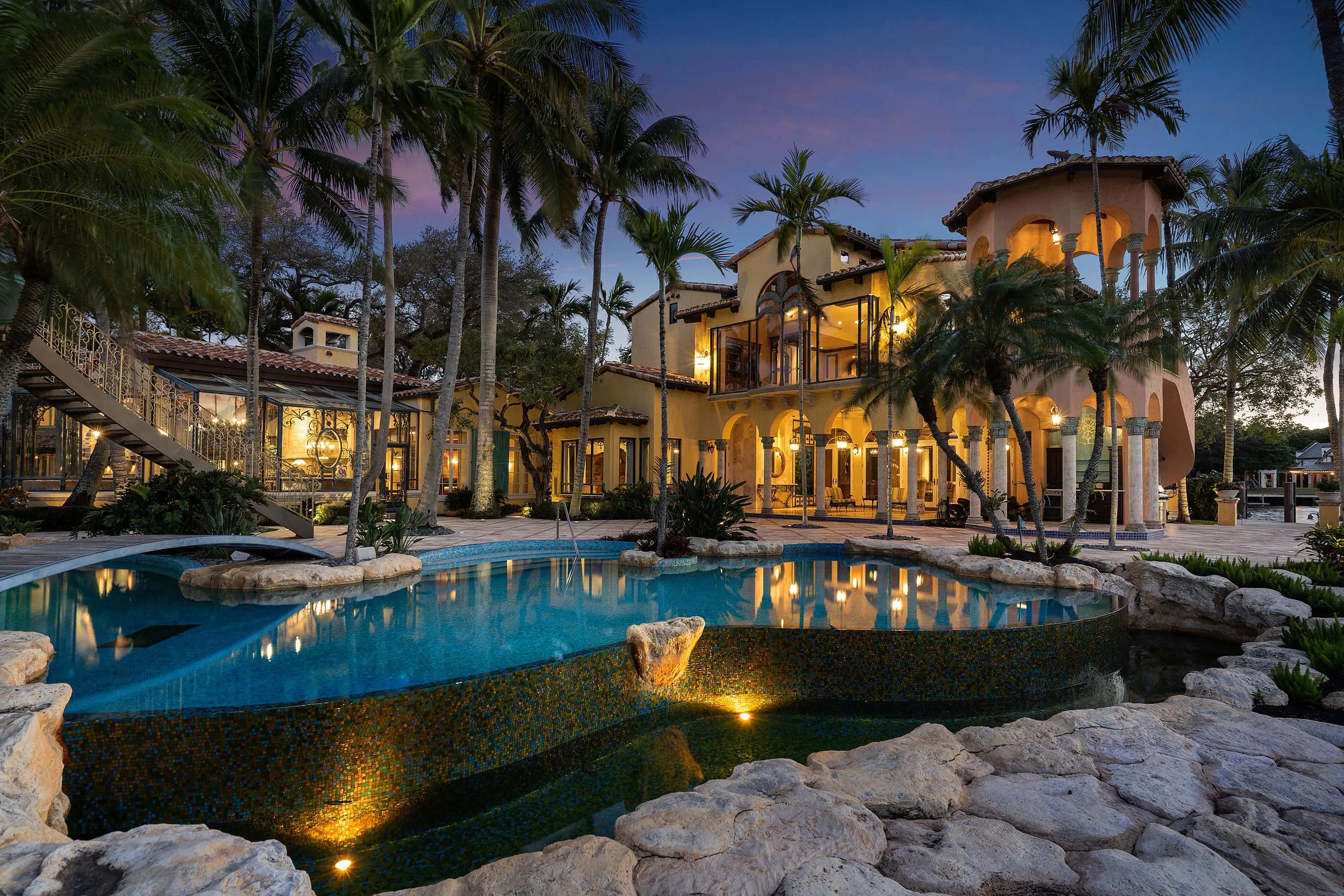
Known as Tarpon Pointe, 1575 Ponce De Leon Drive is currently listed for $27 million and will sell without reserve in cooperation with Billy Nash of Nash Luxury at The Keyes Company. Bidding will be open March 26th through March 28th.
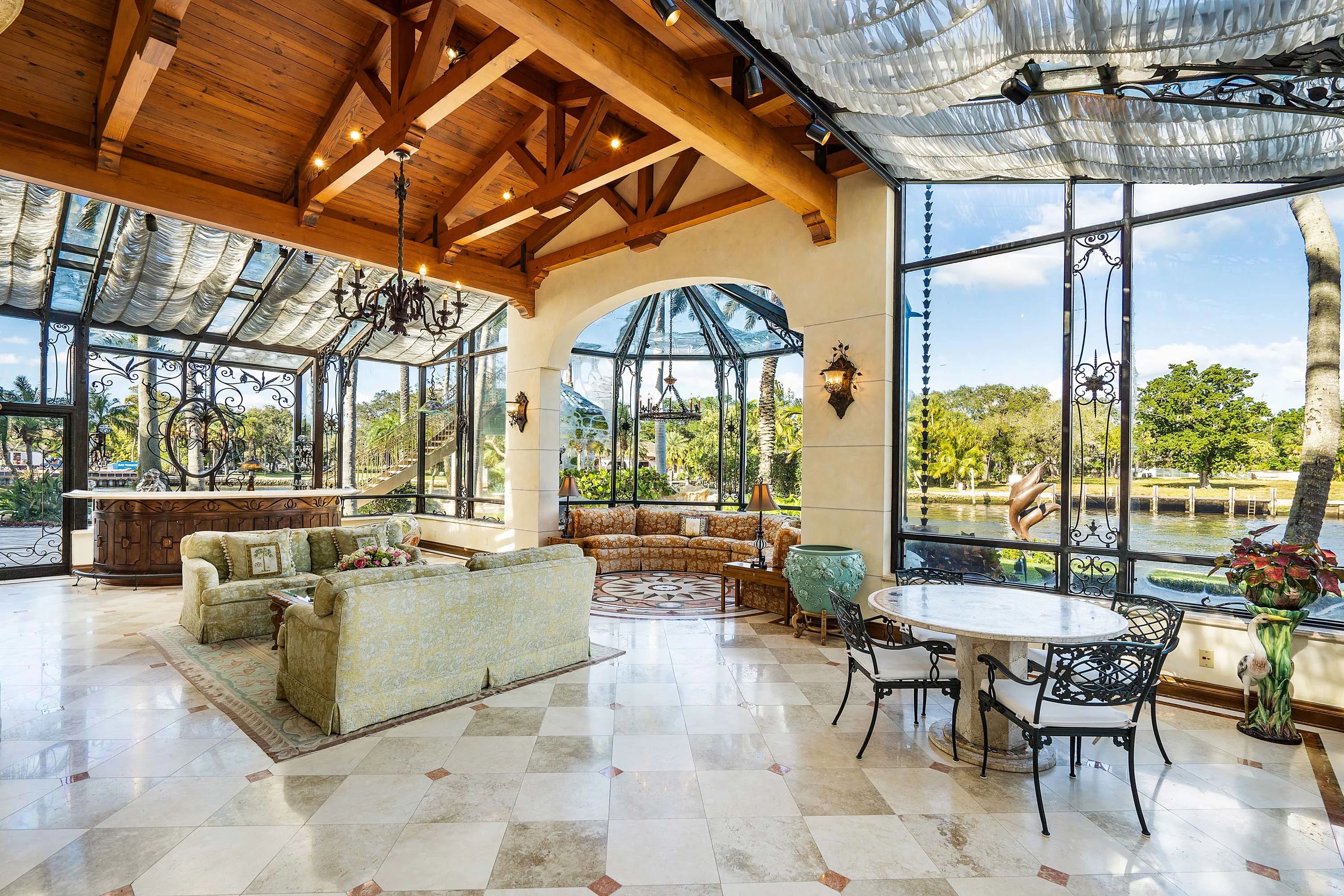
"Mr. Huizenga is and always will be a true legend," said Nash. "It's an honor and privilege to be selling such an epic property on behalf of the family. This auction follows our successful sale on Key Biscayne, which garnered the area's highest sale price in the last four years. I'm confident the Tarpon Pointe auction will do the same by attracting global buyers to this one-of-kind opportunity."
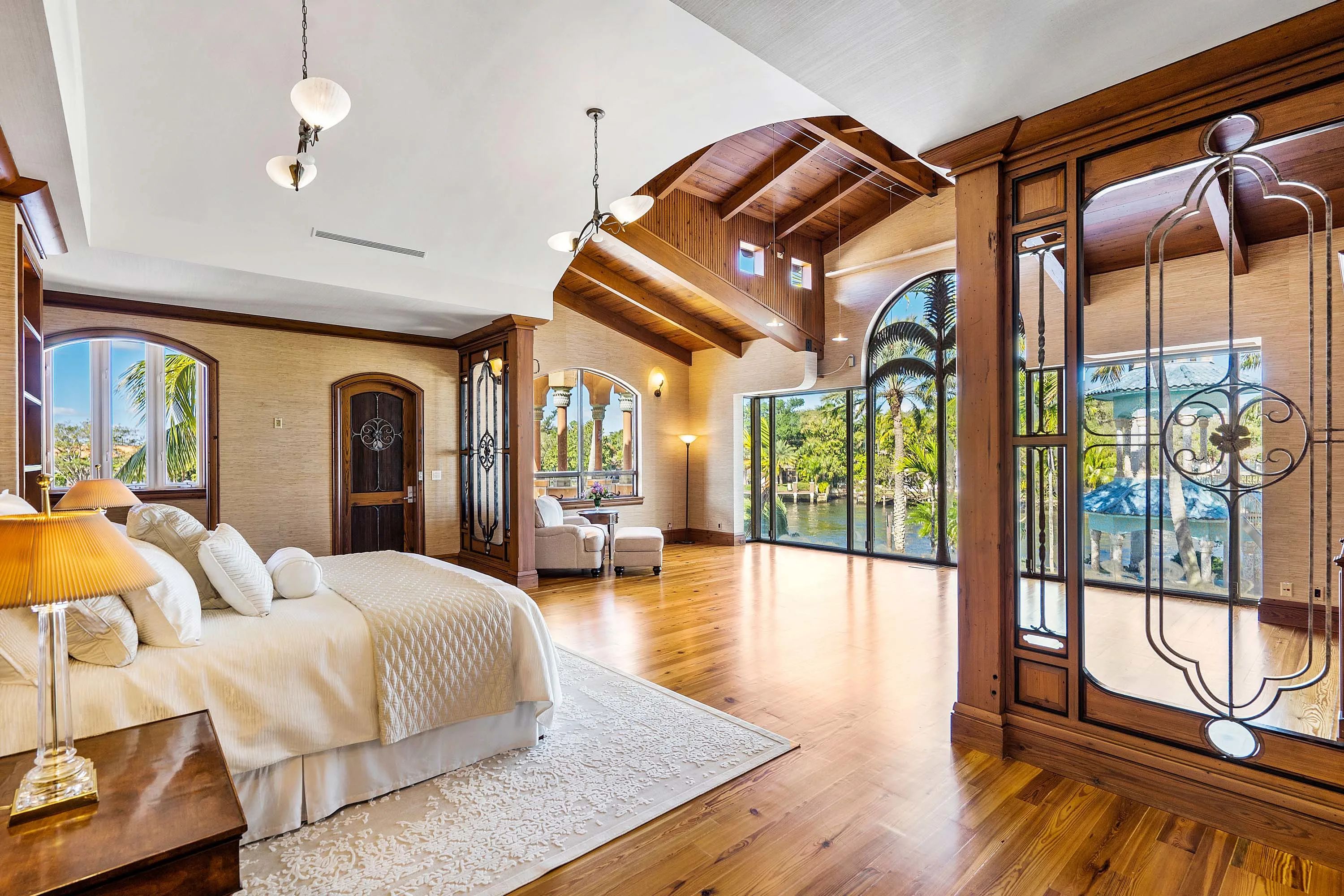
The private Mediterranean-style property situated on 1.41 acres, offering 270-degree river and skyline views, tropical landscaping, and a resort-style pool overlooking the New River with a three-story gazebo with clocktower and curved staircase. The 10-bedroom, five-building compound features cathedral ceilings, custom ironwork and finishes, and floor-to-ceiling windows with river and peninsula water views; a grand foyer with a crystal chandelier; a kitchen with a wood-burning pizza oven and a separate caterer's kitchen; a French-inspired glass conservatory; a master suite with a lounging area; a guest apartment; and an elevator, gym, workshop, theater, billiards room, staff office, and multiple safe rooms.
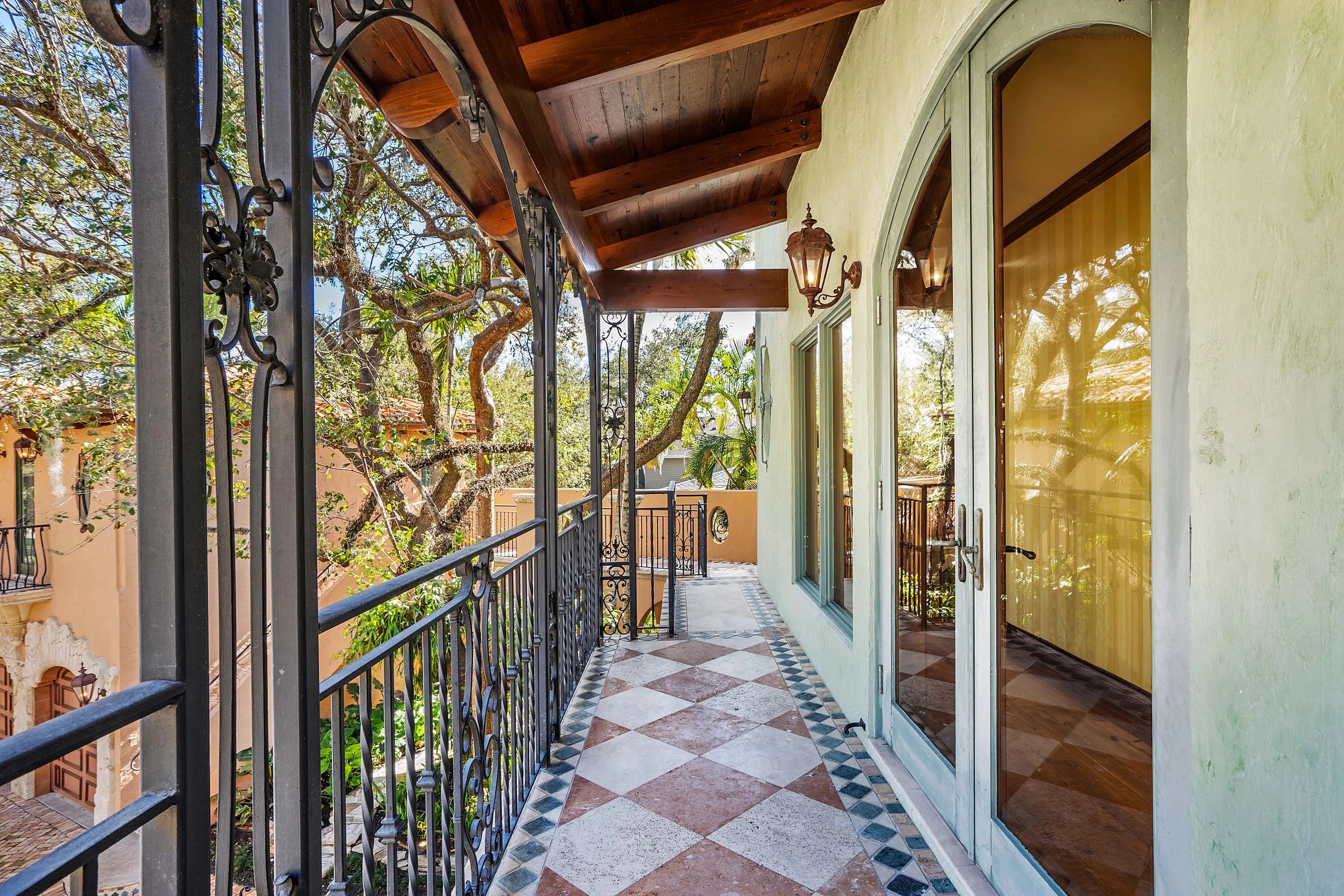
The auction announcement follows the firm's recent successful sale of Playa Vista Isle in nearby Hillsboro Beach, which broke the world record for the highest sale price ever achieved in the U.S. at auction.
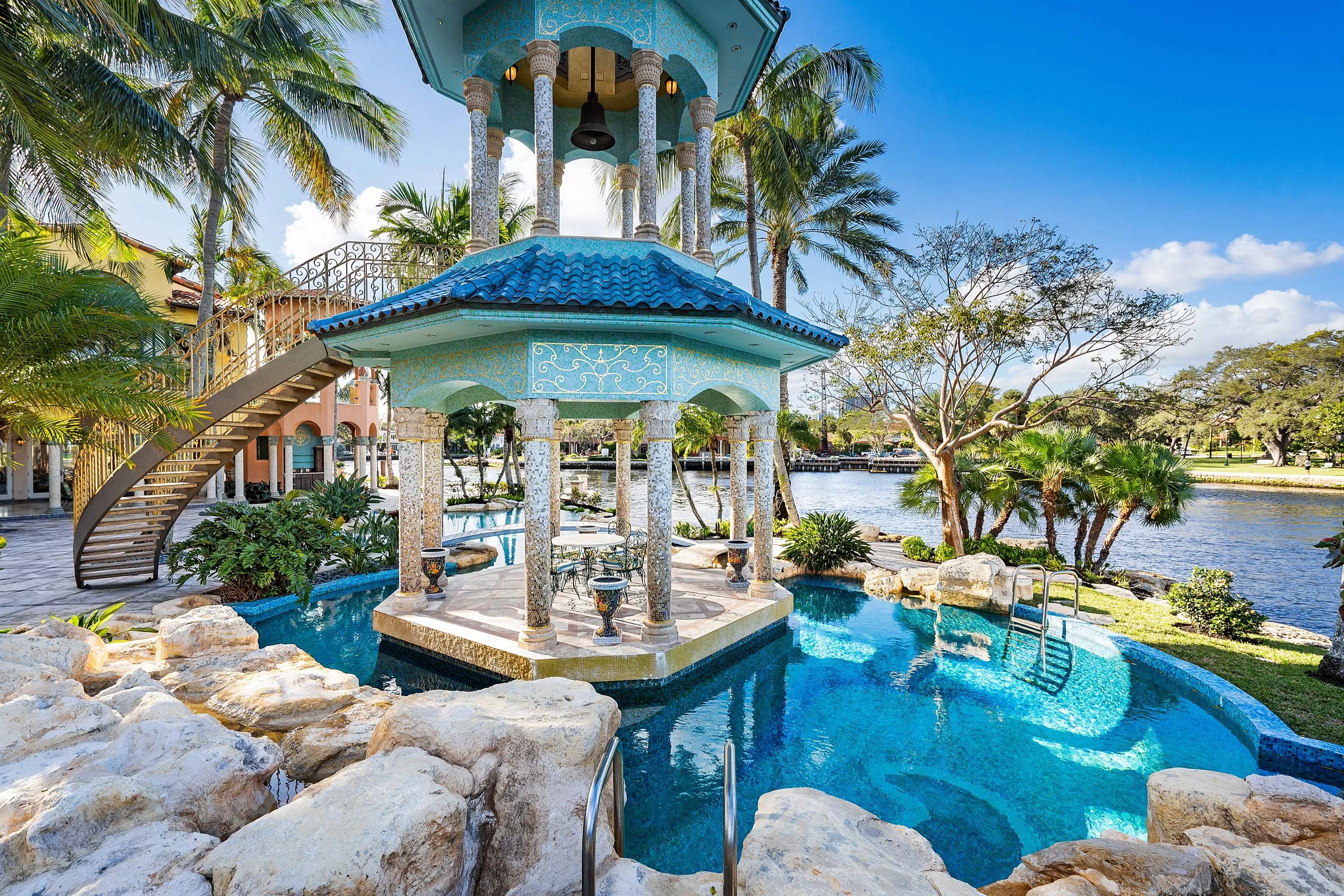
Stay informed with Concierge Auctions offerings, news, & more.
Receive the best from Concierge Auctions, delivered straight to your inbox.
PARTICIPATE
Upcoming Auctions
Auction results.
© 2008- 2024 Concierge Auctions, LLC. All Rights Reserved.
228 Park Avenue S, Suite 70835, New York, NY 10003
+1 212-202-2940

Wayne’s World at Rybovich Shipyard
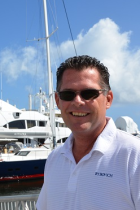
Creating the Rybovich Superyacht Yard & Marina is a continuing process for Wayne Huizenga Jr. and his crew.
Sometime in 1900, a 16-year old Austro-Hungarian immigrant by the name of John Rybovich, equipped with some carpentry experience and little else, made it to the shores of the eastern United States, passing through Ellis Island and settling in New York City. Finding work in construction and the burgeoning building sector that the ever-expanding metropolis was undergoing, the young Rybovich began to hear conversations about Florida.
With industrialist Henry Flagler’s railroad connecting the northeast to the south and thus responsible for the development of the state’s Atlantic coast, Florida, and in particular Palm Beach, soon became a haunt for the rich and powerful. To John Rybovich, that meant an opportunity to get in on the kind of work he was capable of doing.

H. Wayne Huizenga, a college dropout who built a business empire that included Blockbuster Entertainment, AutoNation and three professional sports franchises, has died. He was 80.
Huizenga died Thursday night at his home, Valerie Hinkell, a longtime assistant, said Friday. She gave no details on the cause of death.
Huizenga had strong ties to the Treasure Coast, particularly Palm City, where he developed The Floridian Golf & Yacht Club.
Huizenga, under his company Stuart Property Holdings Ltd., started amassing property connected to the golf course in 1982, including 12 plots in Martin County, which previously sold for $2.6 million collectively, and four in St. Lucie County, which together had a price tag of $5 million.
On 300 acres straddling the Martin-St. Lucie county line, the 6,916-yard, par-72 golf course has two helicopter landing pads, four guest cottages, a deepwater marina, a sprawling four-story clubhouse and lush landscaping. The 18-hole course, designed by Gary Player, opened in 1996.
More: Floridian quietly becoming a home for top pros thanks to owner Jim Crane
Membership to the club was by invitation only, so most Treasure Coast residents knew about it only through frequent fireworks displays and celebrity comings and goings.
The wide array of celebrity visitors to The Floridian included numerous professional golfers, Miami Dolphins quarterbacks Dan Marino and Bob Griese, radio host Rush Limbaugh, former New York City Mayor (and billionaire in his own right) Michael Bloomberg, General Electric CEO Jack Welch, All-Pro football player and TV sports analyst Ahmad Rashad, basketball legend Julius "Dr. J." Erving and singer Michael Bolton.
President Barack Obama visited twice during his administration, in 2013 and 2015, after Huizenga had sold the club April 1, 2010, for $25.6 million to Jim Crane, owner of the Houston Astros.
MORE: President Obama chooses The Floridian
Charitable giving
Huizenga and his wife, Marti, spent less time on the Treasure Coast after selling The Floridian but kept membership at Palm City Presbyterian Church, said the Rev. David Mauldin, the pastor. Marti Huizenga died in 2017.
"He was loved and will be remembered by a lot of people here for his humility, his faith and his generosity," Mauldin said.
The Huizengas donated most of the money for what became the church's Wayne and Marti Huizenga Family Life Center, which was built in 2012 and features a gymnasium and large kitchen.
"He asked me what I wanted to do at the church and how he could help," said the Rev. Richard Anderson, former senior pastor. "There was no stipulation on the cost. ... He was incredibly generous financially, one of the kindest individuals I've met in 41 years in the ministry."
Whenever the church had patriotic programs, Huizenga "wouldn't miss one for the world," Anderson said. "He'd always have tears in his eyes. He loved the United States of America and wanted the best for the country."
The Boys & Girls Club in Palm City is named for Huizenga because a donation from his wife paid most of converting a former fire station into a clubhouse.
"It was her birthday gift to him about nine years ago," said Renee Booth, development officer for the Boys & Girls Club of Martin County.
"A lot of people will remember Mr. Huizenga for his business acumen," Booth said, "but we knew him for his generous heart. As a result, hundreds of kids a year benefit from the Huizengas' generosity."
In 1999, the Huizengas pledged $1 million over three years to the United Way chapters in Martin and St. Lucie counties.
"They split the donation because The Floridian is split between Martin and St. Lucie counties," said Lucy Corley, director of community engagement at the Martin County chapter.
Tom Kenny, a former Martin County commissioner who has been involved in the real estate-and-development industry for four decades, said he enjoyed working for Huizenga for 14 years on several projects including The Floridian.
“The Floridian, it was hands-on,” Kenny said. “He’s the kind of guy who would think nothing of calling you at 2 o’clock in the morning and say, ‘Hey, what do you think of this?’”
Huizenga had high standards for everything he did, Kenny said.
“He formed Waste Management, but you never met a guy who was as clean as he was,” Kennny said. “Everything around him was clean. Sometimes it almost got to the extreme. They bought a (beach) house in Nantucket. They’ve got a lot of seaweed. He had a guy whose job was to rake up the seaweed every day.”
Huizenga also enjoyed a good practical joke, Kenny said. During a planning discussion for The Floridian at Huizenga's home near Grandfather Mountain, North Carolina, Huizenga lured Kenny onto a rope bridge between two mountains, even though he knew Kenny was afraid of heights.
“I’m about halfway across this thing, and he’s behind me, and he starts swinging the bridge and just started laughing, laughing and laughing,” Kenny said. “He had laser-blue eyes and they just lit up when he laughed. I’ll always remember saying, ‘You son of a gun; I’m going to get you for this.’ He laughed and laughed longer.”
“He was funny, he was a good guy, but you sure didn’t want to piss him off,” Kenny said. “He was just intimidating. He was Wayne Huizenga. If you were going to argue with him, you better have a strong case. But he wasn’t the kind of guy who it was his way or the highway. If you had a point, he would listen to your point and then do it his way.”
H. Lee Moffitt, former speaker of the Florida House of Representatives who founded the Tampa cancer center that bears his name, said Wayne and Marti Huizenga donated several million dollars for cancer research.
“It was so transformational in many ways," Moffitt said. "We were able to have research done at the cancer center that we would not otherwise be able to do but for Wayne and Marti.”
Moffitt said he and his wife, renowned interior designer Dianne Davant, traveled throughout Europe with the Huizengas.
“I remember one time we flew nonstop from Tennessee to Moscow, Russia, on Wayne’s jet and got a wonderful tour of Russia as well as all of the Scandanavian countries,” Moffitt said.
"He loved golf and we played golf in Ireland a lot,” Moffitt said. “There are several courses over in Ireland, and whenever they knew Wayne was coming into town, they would put up Miami Dolphins flags in his honor.”
“We’ve been thinking and talking about Wayne all day,” Moffitt said, speaking Friday from a golf course at The Floridian. “In fact, the only hole-in-one Wayne got in all the years he played golf was here at The Floridian.”
Humble beginnings
Starting with a single garbage truck in 1968, Huzienga built Waste Management Inc. into a Fortune 500 company. He bought independent sanitation engineering companies, and by the time he took the company public in 1972, he had completed the acquisition of 133 small-time haulers.
By 1983, Waste Management was the largest waste-disposal company in the United States.
More: 6 benefits of a TCPalm digital subscription
The business model worked again with Blockbuster Video. Buying his first stores in 1987, he built it into the leading movie-rental chain nine years later. In 1996, he formed AutoNation and built it into a Fortune 500 company.
Huizenga was founding owner of baseball’s Florida Marlins and the NHL Florida Panthers — expansion teams that played their first games in 1993. He bought the Dolphins and their stadium for $168 million in 1994 from the children of founder Joe Robbie, but had sold all three teams by 2009.
The Marlins won the 1997 World Series, and the Panthers reached the Stanley Cup Final in 1996, but Huizenga’s beloved Dolphins never reached a Super Bowl while he owned the team.
“If I have one disappointment, the disappointment would be that we did not bring a championship home,” Huizenga said shortly after he sold the Dolphins to New York real estate billionaire Stephen Ross. “It’s something we failed to do.”
Huizenga cracked Forbes’ list of the 100 richest Americans, becoming chairman of Republic Services, one of the nation’s top waste-management companies, and AutoNation, the nation’s largest automotive retailer. In 2013, Forbes estimated his wealth at $2.5 billion.
Huizenga was a five-time recipient of Financial World magazine’s “CEO of the Year” award, and was the Ernst & Young “2005 World Entrepreneur of the Year.”
Regarding his business acumen, Huzienga said: “You just have to be in the right place at the right time. It can only happen in America.”
Huizenga’s first sports love was the Dolphins. He had been a season-ticket holder since their first season in 1966. But he fared better in the NFL as a businessman than as a sports fan.
He turned a nifty profit by selling the Dolphins and their stadium for $1.1 billion, nearly seven times what he paid to become sole owner. But he knew the bottom line in the NFL is championships, and his Dolphins perennially came up short.
Harry Wayne Huizenga was born in the Chicago suburbs on Dec. 29, 1937, to a family of garbage haulers. He began his business career in Pompano Beach in 1962, driving a garbage truck from 2 a.m. to noon each day for $500 a month.
In September 1960, he married Joyce VanderWagon. Together they had two children, Wayne Jr. and Scott. They divorced in 1966. Wayne married his second wife, Marti Goldsby, in April 1972.
The Associated Press contributed to this report.

- Custom Builds
- Current Projects
- On the Drawing Board
- In the Media
- Vintage Boats
- Colorful Characters
- Family Fishing
- The Rybovich Crew
- Boats For Sale

Our History
Proudly a part of the fabric of Palm Beach County, Florida since 1910, we began building boats for the same reason we continue today – to improve on what is on the water. What began as a commercial fishing operation and a small boat repair business has since evolved into the builder of the world's premier sportfishing yachts, unrivaled in design and finish, and synonymous with innovation and the pursuit of perfection. While our family business has operated at different locations and with different names over the years, we have always subscribed to the same philosophy: Listen, think, and create. That philosophy is grounded in hard work, a dedication to our craft, and the partnership that we forge with every customer that puts their trust in us.
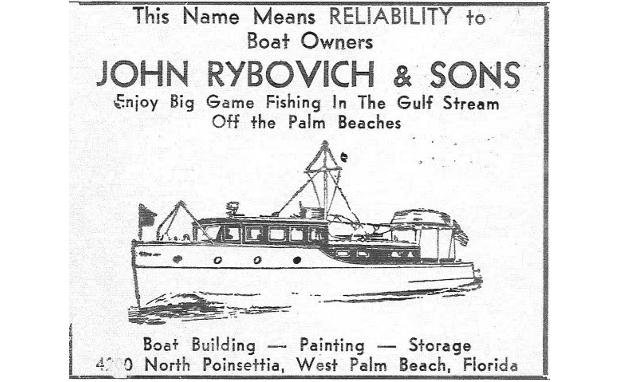
The Birth of John Rybovich & Sons
In 1919, John "Pop" Rybovich started his small commercial boat repair yard when he moved from commercial fishing to servicing the boats of the early commercial fishing fleet of the Palm Beach area. The West Palm Beach yard quickly gained a reputation for its skill and attentiveness, and as the sportfishing concept of the 1930's grew in popularity, Pop and his three sons, Johnny, Tommy and Emil, were at the center of a new industry converting the power cruisers of the nearby Palm Beach elite to chase Sailfish just outside Lake Worth Inlet.
Miss Chevy II
Following the return of Johnny, Tommy and Emil from World War II, each with the skills they had developed overseas, the idea was born to build a boat dedicated to sportfishing. In 1947, that idea became a reality, and the first custom sportfishing boat, Miss Chevy II , was launched. In the years that followed, the sport that was their passion as well as their livelihood grew in popularity, and the boys grew with it, honing their skills and working with owners to build a better-riding, more innovative and more beautiful boat.
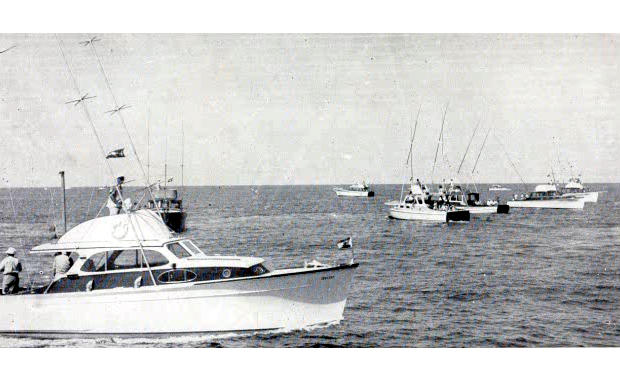
The Broken Sheer and Miss Chevy IV
Tommy's passing.
From 1947 to 1972, the brothers launched 75 hulls, each better than the last and each with their own unique character and innovations. Johnny, the fisherman, brought new ideas and oversaw management, Tommy, the designer and builder, oversaw the carpentry and painting trades, and Emil, the engineer, directed all mechanical and electrical work in new construction as well as in service. Of the three dedicated brothers, it was Tommy's obsession with his work that became legendary and provided the energy and inspiration in the yard's incessant quest for perfection. However, two years after the passing of the family patriarch, Pop Rybovich, Tommy Rybovich passed from cancer in 1972. The soul of the yard, and the head of design and hull building, had passed far too young at the age of 52.

New Owners of the Family Business
Michael becomes head boat builder.
By the time of the sale in 1975, Michael Rybovich, Emil’s son and the next generation of Rybovich boat builders, was working at the family boatyard developing his skills as a carpenter, while fishing when the time allowed. The new owner, Bob Fisher, insisted that Johnny and Emil (and Michael) continue working at their family’s business. But, by 1980, both Johnny and Emil found the changes were too much for their liking and decided to part ways with the business – around this time, Michael became the head boat builder.

A New Family Business
In 1984, Michael, too, decided to leave and with his father, Emil, his brother, Marty Evans, and family friend, Ed Bussey, started a boat building company called Rybovich International with the goal continuing to innovate the world of sportfishing and build a better boat. The first of those new hulls was Ruthie , a 32' Walkaround built for Charlie Bouchard, based on a concept that legendary angler, Nick Smith, had applied to a 30' Daytona . The boat proved a great fishing platform and, with her new bottom, could fish in rough water alongside boats twice her size.
Ryco Marine
Following the second sale of the original family business in 1986, a lawsuit forced Rybovich International to abandon their name, as well as the " Rybovich signature" broken sheer and double handrail designs. Vowing to continue on and not wanting to get involved in a lengthy legal battle, Ryco Marine was born. The trend of building larger sportfishing boats continued, and by the mid-1990's, Ryco Marine was building boats into the 60' class.
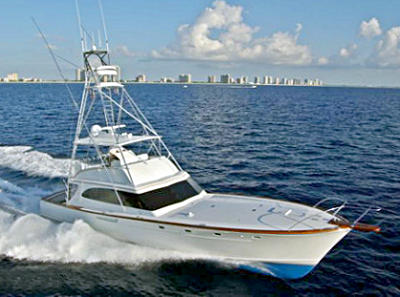

Back to the Family Business
By the early 2000s, the original family business was in the hands of H. Wayne Huizenga Jr., the fourth owner since the family sold the business in 1975. In 2005, following Hurricane Wilma and extensive damage to the Ryco Marine facility, a partnership was formed and Michael joined with Huizenga – a Rybovich was once again building Rybovich boats under the Rybovich name. For the next four years the new company flourished, and during this time, Rybovich & Sons delivered five boats from 54 to 78 feet, the last two being the largest ever built under the family name. As the world recession deepened in 2008, the once full order book became an empty testament to the bad economy. In early 2010, management was forced to make several difficult decisions, including shelving new construction altogether to focus on the development of a full-service super yacht marina at the Riviera Beach site.
Michael Rybovich & Sons
Following the Great Recession of 2008 and a desire to focus on a super yacht marina and service yard, the partnership with H. Wayne Huizenga Jr. was amicably dissolved, and the search for a new home began. Soon after, the most recent rebirth of the Rybovich boat building name came to fruition when Michael and his wife Julia (with the help of family friend, Larry Wilson) purchased the old E&H Boat Works in Palm Beach Gardens, FL and opened Michael Rybovich & Sons Custom Boat Works . Today, we operate as a family business dedicated to the same ideals of innovation and the pursuit of perfection that helped build the Rybovich name. Michael, along with his two sons, Dusty Rybovich and Alex Gill , and the most talented crew in the industry, strive to carry on a tradition that started more than 100 years ago in a small boatyard in West Palm Beach.
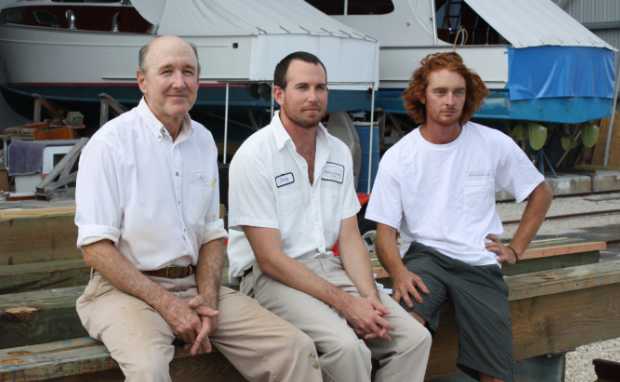
The Unabridged History
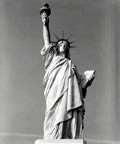
In 1934, Gifford, the Cass brothers, Bill Fagen , and Lloyd Knowles collaborated in the design and building of a reel that would stand up to the stress of hooking and landing large Marlin and Tuna. This reel became known as the Knowles Tuna Reel . In 1935, Ernest Hemingway landed the first un-mutillated Giant Bluefin Tuna in the Bahamas. In 1936, Fred Grieten applied for a patent for the first Fin-Nor fishing reel , which was built to Tommy Gifford's specifications. In the 1930s, Frank O'Brien designed and built the Tycoon Bimini King rod which would provide the mount and the leverage for the new reel technology. The new equipment provided sportsmen with the means and the advent of the 1939 Cat Cay Tuna Tournament provided the arena. In 1937 Johnny was invited to fish Bimini and Cat Cay with a local captain and landed his first Blue Marlin. Two years later he landed his first Giant Bluefin. Johnny was beginning to realize the desperate need for a boat designed and built specifically for big game sport fishing but the realization of that concept would have to wait. His country would soon need his and his brothers' services for bigger fish.
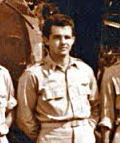
It is clear that all three young men developed an even greater interest in the family business and acquired an education in their respective special talents while in their country's service. Johnny's service taught him business skills and introduced him to the emerging material technology in Military hardware. Emil, a self taught mechanical engineer, was exposed to the engineering and performance standards within the fleet of Army boats for which he was responsible. Tommy was absorbed with aerodynamics, aircraft construction, and the beauty and efficiency of a clean line which is so important in aircraft design. The combination of these skills post war would prove to be a study in excellence.
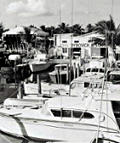
Of the three dedicated brothers, it was Tommy 's obsession with his work that became legendary and provided the energy and inspiration in the yard's incessant quest for perfection. He worked from eight in the morning to eight at night, went home for dinner and returned to the yard, typically working until eleven p.m. and beyond. Sundays were half-days to allow time for the family. With no formal training in naval architecture, Tommy's early designs were based on known lengths, beams, and displacements of similar vessels that were accessible in the service yard. Suffice it to say that from the waterline up, the design was all his.
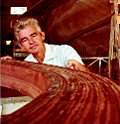
The first project in which he was involved was the Chevy Clipper , a 47' long-range fisherman for none other than Charles Johnson . His third Rybovich build, Chevy Clipper again satisfied Johnson's thirst for having something no one else had. With a galley and salon under a forward trunk, crew forward, and a private master suite under an aft trunk, she combined the modern broken sheer with the additional volume provided by a traditional trunk arrangement fore and aft with a six-foot fishing cockpit. To eliminate the inefficiency of gasoline engines with enough power to push a boat of that size at a respectable cruise speed, she was the first Rybovich to be built with diesel power . To keep Tommy's sleek profile low, Emil installed a pair of "incline" G.M. 6-71 's which had the blocks rotated along the shaft centerline to lower the height by 5" compared with the original upright Grey Marine version. Jack's introduction to Charles Johnson on that project was the beginning of a long relationship between the two pioneers.
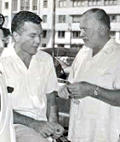
In 1957 Roger Firestone , who owned the 43' " Tireless " insisted that his boat be converted to diesel power and he didn't give a damn how it was accomplished. After a lot of thought, Johnny and Emil decided to go the other way. Instead of raising the boat, they would drop the engines --- literally. They cut out the bottom of the boat beneath the oil pan and gear and dropped the Caterpillar engines that Firestone had specified, straight down between the main stringers. When John Sr. walked by the boat the following day and saw one of the engines protruding for the bottom of the hull he gave Johnny hell for ruining the man's boat. Johnny tried to explain but the old man would have none of it. Johnny and Emil did have a plan. They fashioned airfoil-shaped blisters out of fiberglass and projected the shaft log along the new shaft line out the aft end of the blister and glued and bolted the assembly to the hull. When the project was completed the boat had a flatter, more efficient shaft angle and performed beautifully with greater range and no loss in performance. Several other boats were converted in this manor before low profile diesels were made available in the years that followed.
Prior to 1958, the yard used resorcinol glue for most all its adhesive applications. Its use was common in many boatyards and did an adequate job of holding things together, although its adhesive properties were known to diminish over time. That year, a customer named George Molle ordered a boat from Rybovich under one condition, that his boat would be built using a catalyzed epoxy resin instead the conventional glue. Epoxy had been developed for the aircraft industry in WW II as a means of bonding aluminum but as far as anyone knew, it had never been used to glue a wooden boat together. Tommy experimented with the new material and agreed to Molle's request. The new glue turned out to be far stronger and have many more applications than resorcinol and became the standard not only in new construction but in the repair side of the business as well.
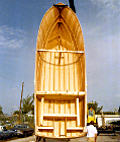
The boat was completed as a yard project and had the first pair of jet-drives installed locally. She was extremely fast but the jet drives produced unpredictable handling characteristics and were soon abandoned for conventional drive. The experiment had been a success. The boat was sold to yard customer Eddie Crawford , and was fished hard for many years from the Palm Beaches to Hawaii. She is still an eye-catcher and in beautiful condition today.
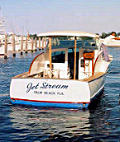
In 1966 Johnny introduced the " Tournament of Champions ", which was a tournament designed to raise money for conservation. At the end of the competition each year, the winner would decide on what conservation project his winnings should be spent. Early sonic tagging experiments on billfish were paid for through funds realized through that tournament. Throughout the 60s, the continued decline in local fishing stocks was a cause for great concern with Johnny. It was clear to him that the mortality rate of sailfish hooked and released on live bait was much higher than those released on dead bait. In 1972 Johnny founded the Gold Cup Tournament , which awarded significantly more points for fish caught on dead bait. These tournaments and a great deal of research projects were born out of Johnny's love and respect for the sport on which he had built his family's business, and for the cause of marine conservation to which he dedicated the last 30 years of his life.
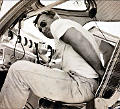
1975 to Present
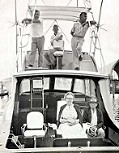
"We continue to subscribe to the same philosophy—listen, think, and create. We are here to build a better boat. It's as simple as that."

Anna Pollack, wife of John Rybovich, Sr.
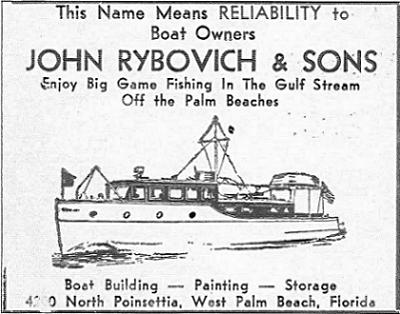
An early print ad for the boatyard
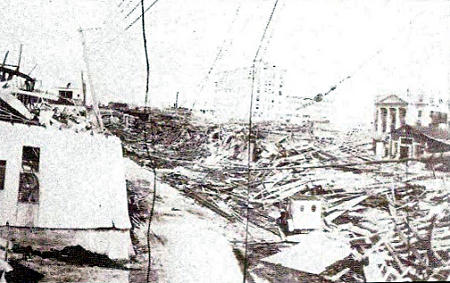
Aftermath of the September 16, 1928 hurricane
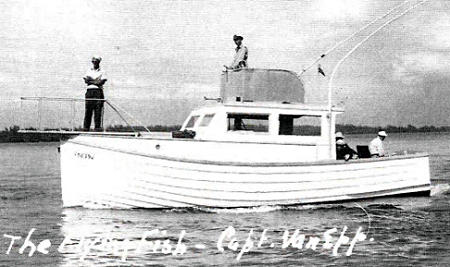
Converting existing cruisers to sportfishing boats by adding outriggers, fishing chairs, gunwale mounted rod holders and topside-mounted controls.
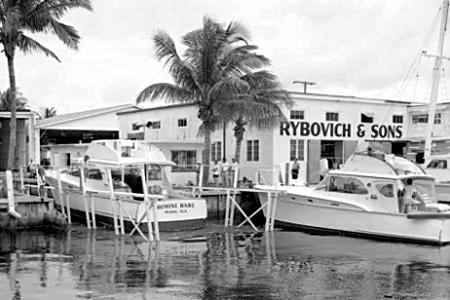
The old Rybovich Boatyard in West Palm Beach
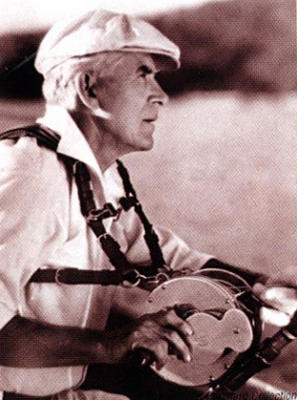
Michael Lerner
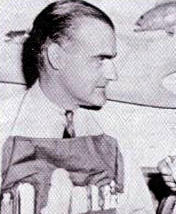
Kip Farrington
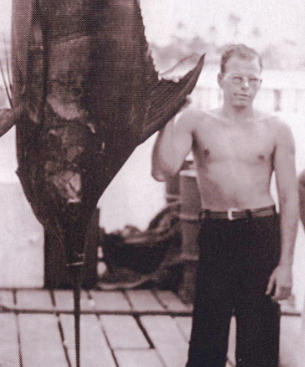
Tommy Gifford with a Blue Marlin
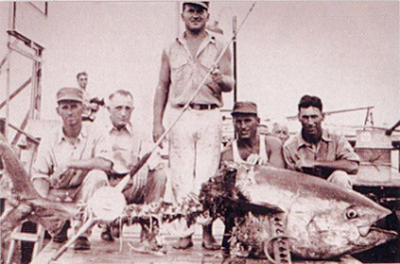
The Cass Brothers with a shark-eaten Tuna
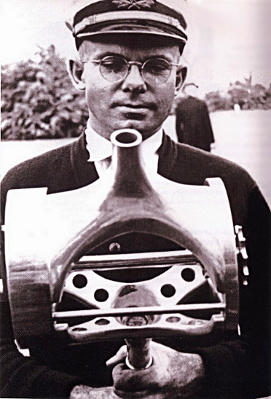
Lloyd Knowles and the Knowles Tuna Reel

Ernest Hemingway fishing for Bluefin Tuna
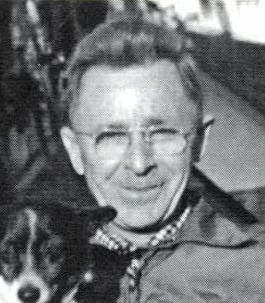
Fred Grieten, developer of the Fin-Nor reel
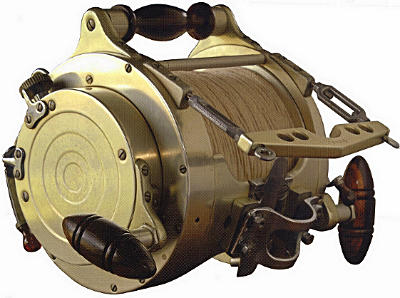
The Fin-Nor big game fishing reel
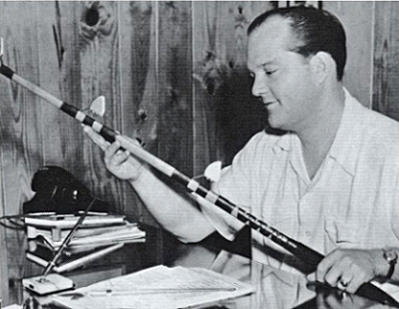
Frank O'Brien, designer of the Tycoon Bimini King rod
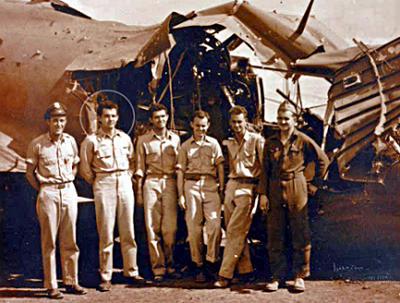
Tommy Rybovich (circled) with crew and battered B-17
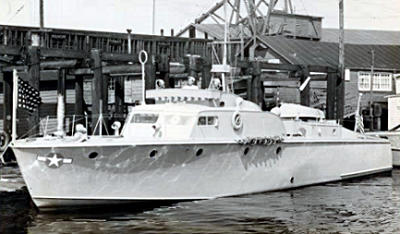
Emil's World War II patrol boat
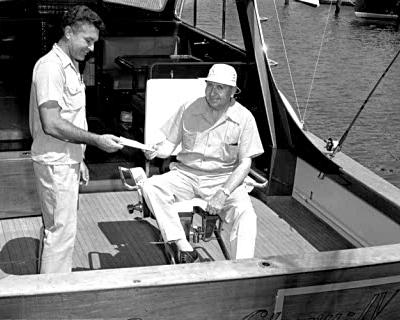
John Rybovich with Charlie Johnson (seated)
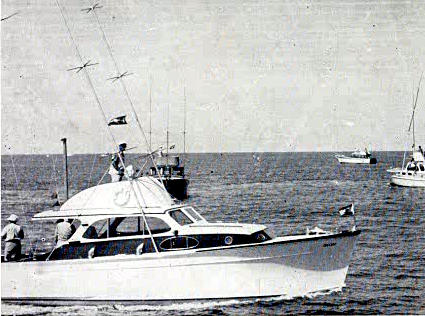
Clari-Jo (hull #2), renamed Legend, built in 1949
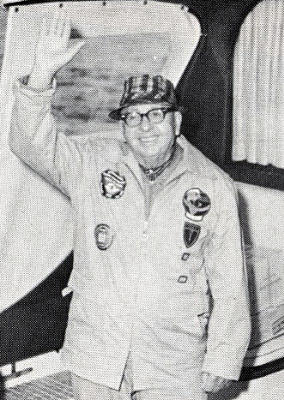
Charles Johnson
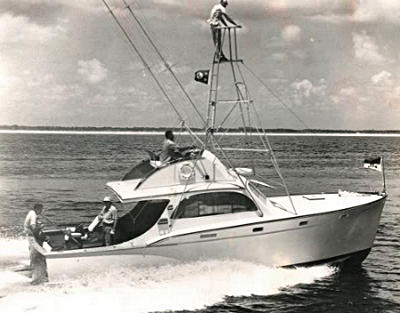
Miss Chevy IV (hull #8) built in 1952
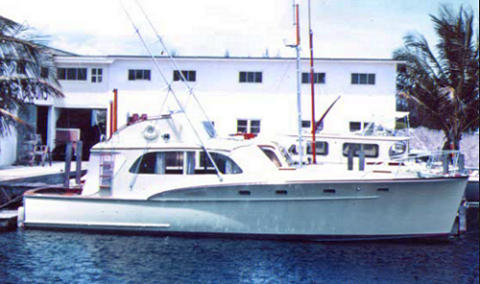
Georgia May (hull #19) launched in 1955
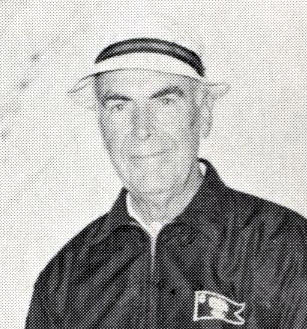
Horace Dale Critz
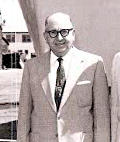
John Rybovich and Ernest Hemingway (2nd & 3rd from left) in Havana, 1956

Gasoline engine
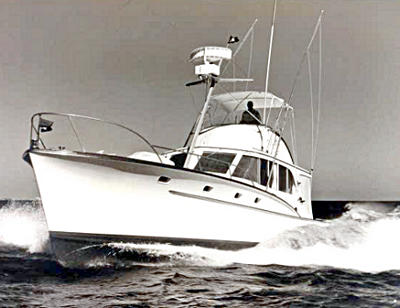
Tireless (hull #28) launched in 1957
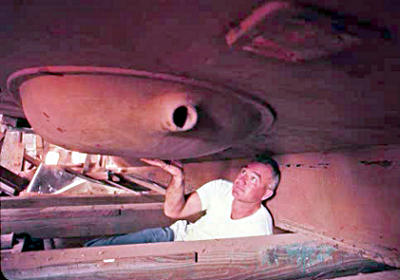
Emil Rybovich with the fiberglass "blister"
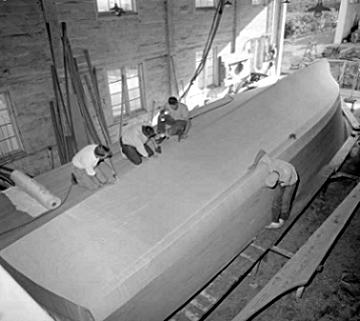
Fiberglassing the hull
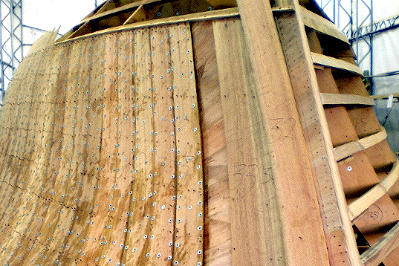
The cold molding process

Rhino (hull #34) launched in 1959

Mahogany planking sliced to 3/8"

Stiff one-piece wooden hull
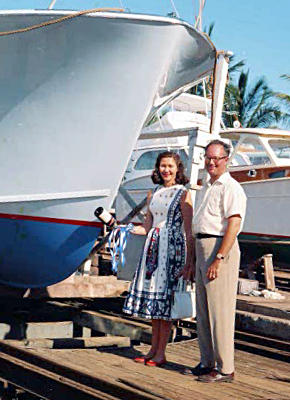
Peter A B Widener, horse breeder and sportsman
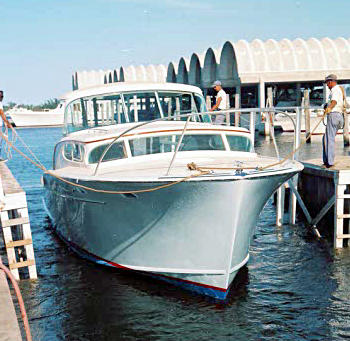
Jet Stream (hull #47) launched in 1961
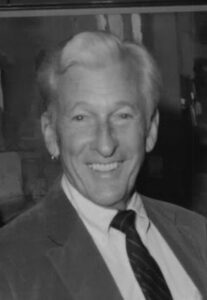
James H. Kimberly, sportsman, socialite and Kleenex heir
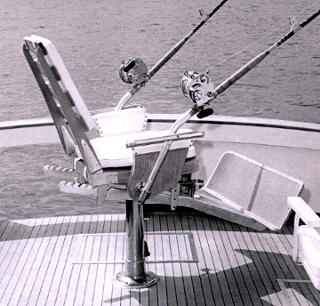
Fighting chair

Kay Rybovich with Sailfish and husband John
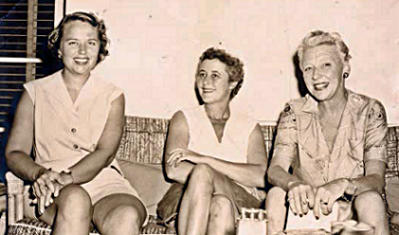
Kay Rybovich, Ginni Sherwood and Dennie Crowninshield, founders of the IWFA

Trophy for the Master's Angling Tournament , sponsored by The Sailfish Club
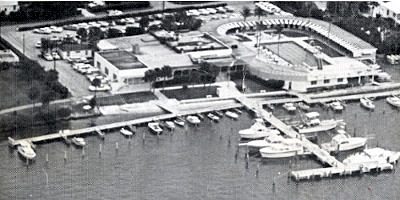
The Sailfish Club in Palm Beach
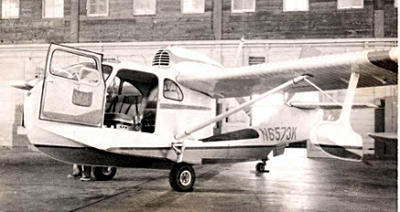
The Republic SeaBee seaplane
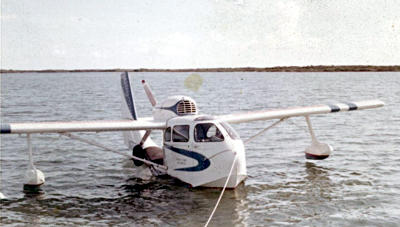
The second Republic SeaBee
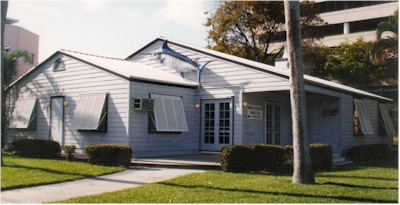
The West Palm Beach Fishing Club
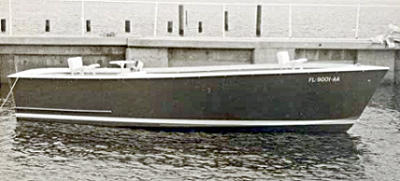
Asinine , forerunner to the modern center-console fishing boat
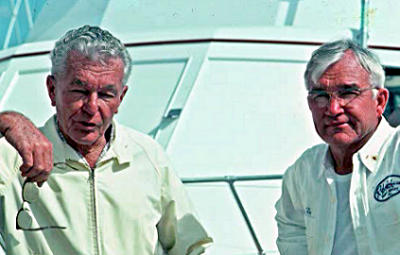
John and Emil Rybovich
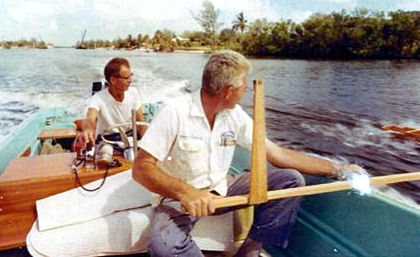
Tommy Rybovich towing a scale model with Giovanni Cardelli
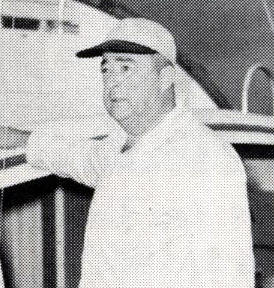
Herbert Clofine
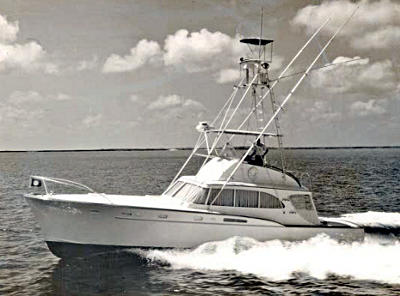
Amigo V (hull #61) launched in 1965
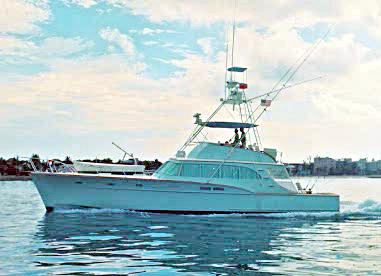
Annabet (hull #69) launched in 1968
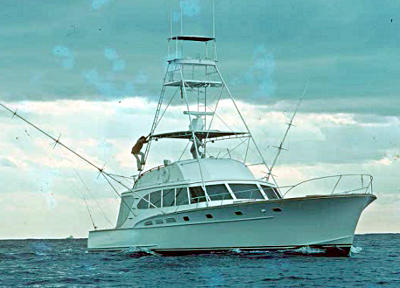
Little Pete (hull #65) launched in 1967

Margaret (hull #73) launched in 1972
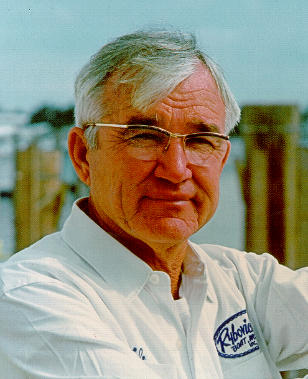
Emil Rybovich
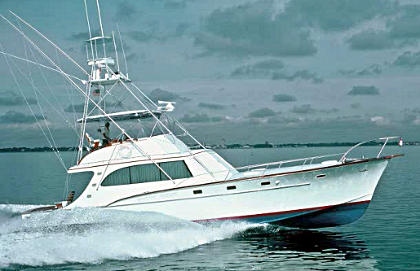
Swamp Fox (hull #79) launched in 1976

Marty Evans
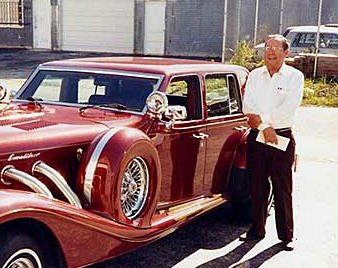
Gary Hilliard
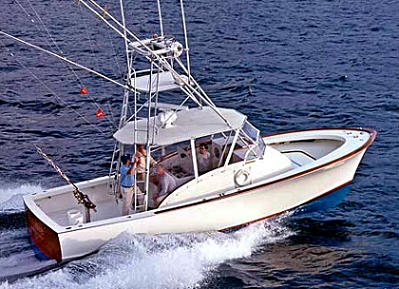
Ruthie (hull #108) launched in 1985
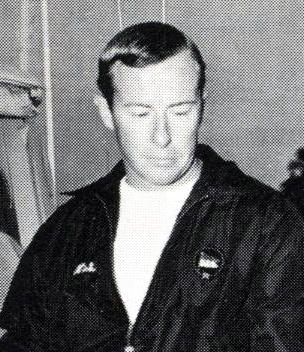
Legendary angler Nick Smith
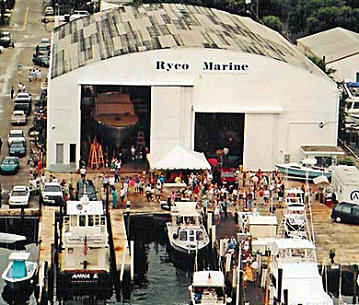
Ryco Marine in Riviera Beach FL
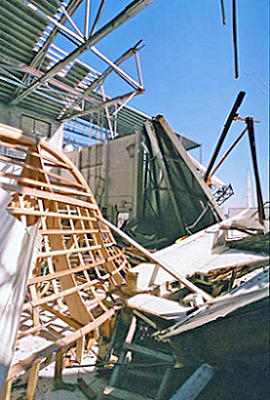
Damage from Hurricane Wilma in October 2005
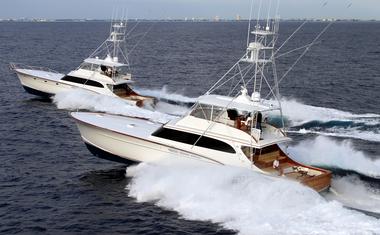
A pair of 78' sportfishermen from 2009-2010
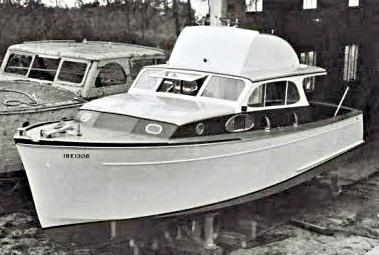
Miss Chevy II (hull #1) launched in 1947
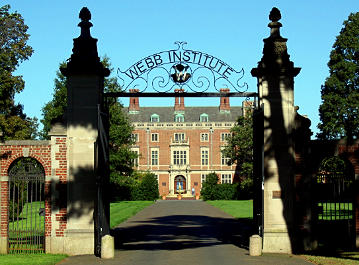
The Webb Institute for Naval Architecture and Marine Engineering

Los Angeles
- San Francisco
- Washington DC

Cover Story
Tommy paul and the road to olympic glory.

Hear Eva Longoria Roar During Women’s History Month As She Leads Her Tequila Brand To Victory

Gordon Ramsay Is Turning Up The Heat In Miami With The Opening Of Lucky Cat

Romero Britto On Transcending The World Of Fine Art to Expand His Massive Empire
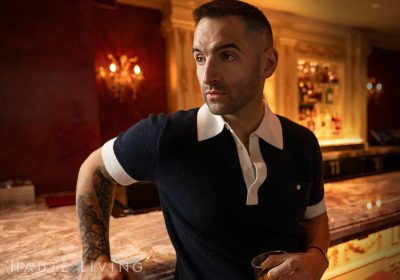
Mario Carbone Is Planning A Major NYC Domination With The Opening Of ZZ’s Club New York
Wayne huizenga sells floridian golf & yacht club.
by Lainey Johnson
Wayne Huizenga knows that for the right price, you must sell.
Bidding adieu to his Floridian Golf & Yacht Club, Mr. Blockbuster will have to take his lavish parties and private golfing elsewhere. The property, which was bought in 1996 for $750,000, was sold last week for $25.6 million to a Texas entrepreneur.
Boasting two helicopter pads, a world-class clubhouse, guest cottages, deep water docks on the St. Lucie River and a 300-acre course designed by Gary Player, the club distributed memberships to the likes of Rush Limbaugh, Michael Douglas and Dolphins Vice President Bill Parcells. The new owner plans to build more cottages and a new fitness center for members.
Clinton at LIV Nightclub for Fundraiser

Haute Restaurant Choices
' . get_the_title() . ' ' ); >, related articles.

Meghan, The Duchess of Sussex, Heads To Children’s
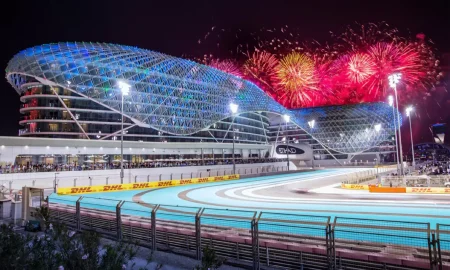
Where To Stay In The Lap Of Luxury At F1 Races Around
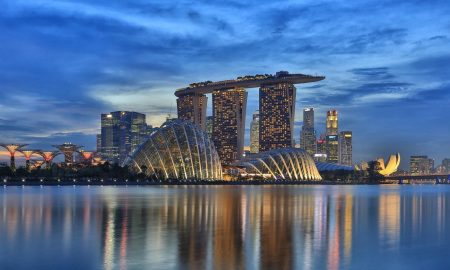
How To Have The Best Night Ever In Singapore: Choose Your
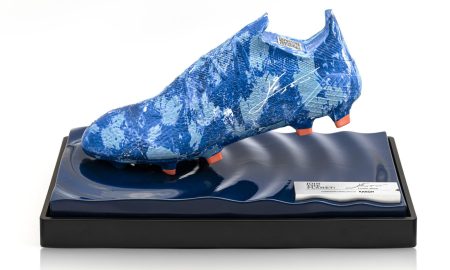
Lionel Messi Is Saving The Environment, One Cleat At A
Latest news, you might also like.

Meghan, The Duchess of Sussex, Heads To Children’s Hospital Los Angeles For A Day Of Philanthropy

Louis Vuitton Unveils “A Perfume Atlas:” A Global Sensory Journey
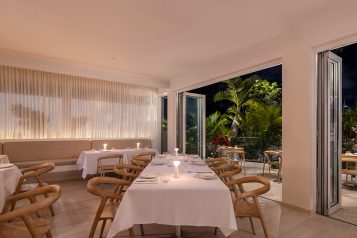
La Màrtola Brings Elevated European Riviera Dining To Miami
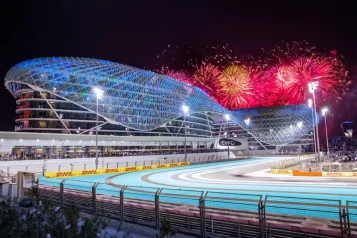
Where To Stay In The Lap Of Luxury At F1 Races Around The World
Inside this issue.

STAY CONNECTED

DISCOVER THE BEST KEPT SECRETS IN YOUR CITY

* All fields are mandatory

Wayne Huizenga Jr. faces lawsuit tied to West Palm Beach mansion
Boca Raton-based CitiQuiet alleges billionaire heir, his wife Fonda and their general contractor won’t pay $144K for work done at the couple’s new home
Billionaire heir H. Wayne Huizenga Jr. and his wife, Fonda, are caught in the crossfire over an alleged six-figure sum owed for doors and windows installed at the couple’s new waterfront mansion in West Palm Beach.
Boca Raton-based CitiQuiet Windows and Doors sued the Huizengas and their general contractor, Big Dog Construction Services, in Palm Beach County Circuit Court. The Jan. 4 complaint alleges CitiQuiet is owed $143,765 for work the company performed at the almost completed modern home at 3100 North Flagler Drive. The firm did receive $297,982 for some of its services, documents attached to the lawsuit show.
Bruce Loren, the attorney for Huizenga Jr. and his spouse, said CitiQuiet has no legal standing to go after his clients.
“We want to make it clear that this is a fight for Big Dog,” Loren said. “They know the Huizengas are a big name, and figured they could use it as leverage.”
David Rosenof, president of Coconut Creek-based Big Dog, declined comment. CitiQuiet’s lawyer Alan Raines did not respond to a voicemail and an email requesting comment.
Sign Up for the undefined Newsletter
In 2018, the Huizengas purchased the coastal property for $5 million from Hollywood celebrity Rosie O’Donnell . In 2020, the couple obtained a $6 million mortgage from Synovus Bank. The same year, Big Dog demolished a five-bedroom house previously on the site, and began construction in 2021, records show.
Huizenga Jr. is president of Fort Lauderdale-based Huizenga Holdings and CEO of Rybovich Superyacht Marina in West Palm Beach . His late father co-founded Waste Management, launched Blockbuster Video in the 1990s and previously owned South Florida sports teams: the Miami Marlins, the Miami Dolphins and the Florida Panthers.
The new two-story Huizenga homestead is about 98 percent completed, Loren said. “We are almost done,” he said. “We just have some punch list work left, and we have our certificate of occupancy.”
Subcontractor lawsuits are not uncommon, but the Huizengas had no direct interactions with CitiQuiet, Loren said. “We didn’t hire them, and we don’t have a contract with them,” he said. “The only deal we have is with Big Dog.”
Big Dog claims that CitiQuiet’s windows installation work is defective, and it is not entitled to its final payment, Loren said. Furthermore, CitiQuiet did not adhere to Florida’s construction lien law that provides subcontractors with a legal mechanism to collect alleged non-payment of work, Loren added.

Huizenga sells Floridian Golf & Yacht Club…
Share this:.
- Click to share on Facebook (Opens in new window)
- Click to share on X (Opens in new window)
Daily e-Edition
Evening e-Edition
- Election 2024
- Restaurants
- Real Estate
- Things To Do
SUBSCRIBER ONLY
Huizenga sells floridian golf & yacht club to texas entrepreneur.
Billionaire H. Wayne Huizenga sold his private Floridian Golf & Yacht Club to a Texas entrepreneur who plans to revamp the property and keep a home here.
The plush golf course, which straddles Martin and St. Lucie counties, sold on April 1 to Texas-based Floridian Golf Resort, a subsidiary of the Crane Capital Group, whose chairman and CEO is James R. Crane.
“I think Wayne was ready to sell, that was pretty much public,” Crane said in an interview Thursday. “I decided it was a beautiful place, and I am a golfer and have been a member of the club for a year and a half. … It’s a great purchase.”
Crane, based in Houston, said he plans to invest more money in the exclusive golf course by building more cottages and a new fitness center for members.
“We’ll keep the staff intact and probably add more jobs so it will be a positive for the community,” Crane said. “I am still working with architects and developers to … figure out what our strategy will be.”
Crane ran Houston-based EGL Inc., a global transportation and supply chain management company, before it was sold to supply chain management company CEVA Logistics in 2007.
A representative from Fort Lauderdale-based Huizenga Holdings said the sale was a “private transaction” and declined to comment.
“I’ve met [Huizenga] numerous times, played some golf with him, but we’ve never done business together, other than this deal,” Crane said. “He’s a great guy. I guess he thought it was time to turn it over to someone to move it forward. It’s a deal that worked for him and worked for me.”
According to Business Week, Huizenga once extended “free privileges to some 200 friends, relatives and business associates, including actors Michael Douglas and Catherine Zeta-Jones and retired General Electric Corp. Chairman Jack Welch” at the Floridian Golf & Yacht Club.
Spread over 300 acres, the 6,916-yard, par-72 layout golf course boasts two helicopter landing pads, four guest cottages, a deepwater marina, a sprawling four-story clubhouse and lush landscaping. The 18-hole Floridian Yacht & Golf Club designed by Gary Player opened in 1996.
Huizenga, under his company Stuart Property Holdings Ltd., started amassing property connected to the golf course in 1982, according to public records. The deed includes 12 properties in Martin County, which previously sold for $2.6 million collectively, and four in St. Lucie County, which altogether had a price tag of $5 million.
Martin County’s Assistant Property Appraiser Mike Fribourg said Huizenga still owns two vacant parcels and a home at the Rivers End subdivision on Wiregrass Court. Additionally, Huizenga owns the AA Marina on the Indian River in Jensen Beach.
Last October, Huizenga Holdings sold two Martin County parcels, including the former Holiday Inn, to Jensen Beach LLC, a subsidiary of Delray Beach -based Ocean Properties Ltd., owned by Mark, Michael and William Walsh, for $6 million.
“He still owns property and owns a home there [in Martin County]. As far as my knowledge, he told me he would continue to be a member and spend time there,” Crane said. “We’re happy to have him around.”
In March, Huizenga, 72, ranked No. 463 on Forbes magazine’s list of “The World’s Billionaires” with a net worth of $2.1 billion.
More in News

Florida News | COVID pandemic slashed return on Florida tourism marketing efforts, report says

World News | Bodies of 6 foreign aid workers slain in Israeli strikes are transported out of Gaza

Politics | Six proposed constitutional amendments: What Floridians will vote on in November

Crime and Public Safety | Man shot near bowling alley at Gulfstream Park shopping mall

- About ParkNews
- Privacy Policy
FEIG ELECTRONIC: Moscow-City Skyscrapers Streamline Parking Access and Control with Secure RFID
Feig electronic partners with isbc group to deploy ucode dna rfid security and parking access control solution in moscow business district.
Weilburg, Germany — December 3, 2019 — FEIG ELECTRONIC , a leading global supplier of radio frequency identification (RFID) readers and antennas with fifty years of industry experience, announces deployment of the UCODE DNA RFID security and parking contactless identification solution in the Moscow International Business Center, known as Moscow-City, one of the world’s largest business district projects.
The management of Moscow-City not only selected long-range, passive UHF RFID to implement in its controlled parking areas, it also chose to implement UCODE DNA , the highest form of secure RAIN RFID technology, developed by NXP Semiconductors.

Panoramic view of Moscow city and Moskva River at sunset. New modern futuristic skyscrapers of Moscow-City – International Business Center, toned
“Underscoring NXP’s innovation and leadership in developing advanced RAIN RFID technologies, our UCODE DNA was chosen to be incorporated with the FEIG and ISBC implementation of the contactless identification system in the prestigious Moscow-City,” said Mahdi Mekic, marketing director for RAIN RFID with NXP Semiconductors. “This exciting project represents yet another successful deployment of NXP’s contactless portfolio, and showcases our continued ability to meet the high-security requirements of highly demanding applications without compromising user convenience.”
“UCODE DNA is considered the only identification technology to match the physical protection of a barrier with the cybersecurity necessary to truly protect entrances from unauthorized access,” said Manuel Haertlé, senior product manager for FEIG Electronic. “As a respected contactless payment technology company, FEIG applies security know-how from its payment terminals, which are fully certified according to the latest high-class security standards, into our RFID systems. FEIG vehicle access control RFID readers incorporate advanced secure key storage elements, supporting various methods for secure key injection.”
FEIG’s partner ISBC Group provided the knowledge and support for this successful implementation using FEIG’s long-range UHF RFID . The resulting system enables authorized vehicle entry into areas reserved for private residential use or corporate tenants, while also allowing availability of temporary, fee-based visitor parking. Thanks to the cryptographic authentication of UCODE DNA, both the tag and reader must go through an authentication procedure before the reader will validate the data from the tag, which is transmitted wirelessly. This level of authentication is typically used in the most secure data communication networks.
“The system’s two-step authentication means that only authorized equipment can handle the secure protocol and the data exchange with the UCODE DNA based tag. Without the required cryptographic secrets, other readers would query the tag in vain, because the tag’s response cannot be interpreted or understood,” said Andrey Krasovskiy, director of the RFID department at ISBC Group. “On top of this, each data exchange in the authentication process is unique, so even if a malicious actor were to intercept the communication, the transmission is only good for a single exchange and the tag’s unique identity is protected from cloning.”
Established in 1992 and still growing, Moscow-City is the revitalization and transformation of an industrial riverfront into a new, modern, vibrant and upscale business and residential district. A mix of residential, hotel, office, retail and entertainment facilities, it is located about four kilometers west of Red Square along the Moscow River. Twelve of the twenty-three planned facilities have already been completed, with seven currently under construction. Six skyscrapers in Moscow-City reach a height of at least 300 meters, including Europe’s tallest building, Federation Tower, which rises more than 100 stories.
Partnering with ISBC and deploying FEIG Electronic RFID solutions, the Moscow International Business Center is delivering security and access control to its city center today, as it grows into the city of tomorrow.
About FEIG ELECTRONIC
FEIG ELECTRONIC GmbH, a leading global supplier of RFID readers and antennas is one of the few suppliers worldwide offering RFID readers and antennas for all standard operating frequencies: LF (125 kHz), HF (13.56 MHz), UHF (860-960 MHz). A trusted pioneer in RFID with more than 50 years of industry experience, FEIG ELECTRONIC delivers unrivaled data collection, authentication, and identification solutions, as well as secure contactless payment systems. Readers from FEIG ELECTRONIC, which are available for plug-in, desktop, and handheld applications, support next-generation contactless credit cards, debit cards, smart cards, NFC and access control credentials to enable fast, accurate, reliable and secure transactions. For more information, visit: www.feig.de/en
Founded in Moscow in 2002, ISBC Group provides knowledge and support to integrators for their successful implementation of RFID and smart card-based solutions. The company specializes in the distribution of smart card equipment, contact and contactless card manufacturing, smart card and RFID personalization services, and information security. Its Research and Design Center is focused specifically on RFID, primarily HF and UHF solutions with NXP tags, and software development for the smart card industry. For more information visit: https://isbc-cards.com/
← Previous Post
Next Post →
Privacy Overview
- Bahasa Indonesia
- Slovenščina
- Science & Tech
- Russian Kitchen
Le Corbusier’s triumphant return to Moscow
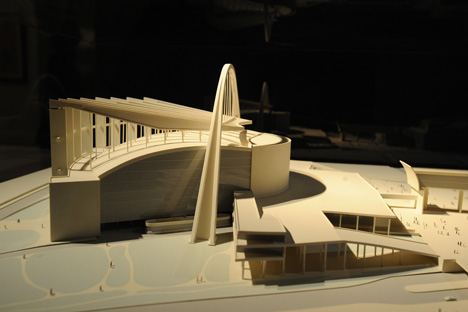
The exhibition of French prominent architect Le Corbusier, held in The Pushkin Museum, brings together the different facets of his talent. Source: ITAR-TASS / Stanislav Krasilnikov
The largest Le Corbusier exhibition in a quarter of a century celebrates the modernist architect’s life and his connection with the city.
Given his affinity with Moscow, it is perhaps surprising that the city had never hosted a major examination of Le Corbusier’s work until now. However, the Pushkin Museum and the Le Corbusier Fund have redressed that discrepancy with the comprehensive exhibition “Secrets of Creation: Between Art and Architecture,” which runs until November 18.
Presenting over 400 exhibits, the exhibition charts Le Corbusier’s development from the young man eagerly sketching buildings on a trip around Europe, to his later years as a prolific and influential architect.
The exhibition brings together the different facets of his talent, showing his publications, artwork and furniture design alongside photographs, models and blueprints of his buildings.
Russian art reveals a new brave world beyond the Black Square
Art-Moscow fair targets younger art collectors
In pictures: 20th century in photographs: 1918-1940
Irina Antonova, director of the Pushkin Museum, said, “It was important for us to also exhibit his art. People know Le Corbusier the architect, but what is less well know is that he was also an artist. Seeing his art and architecture together gives us an insight into his mind and his thought-processes.”
What becomes obvious to visitors of the exhibition is that Le Corbusier was a man driven by a single-minded vision of how form and lines should interact, a vision he was able to express across multiple genres.
The upper wings of the Pushkin Museum are separated by the central stairs and two long balconies. The organizers have exploited this space, allowing comparison of Le Corbusier’s different art forms. On one side there are large paintings in the Purist style he adapted from Cubism, while on the other wall there are panoramic photographs of his famous buildings.
Le Corbusier was a theorist, producing many pamphlets and manifestos which outlined his view that rigorous urban planning could make society more productive and raise the average standard of living.
It was his affinity with constructivism, and its accompanying vision of the way architecture could shape society, which drew him to visit the Soviet Union, where, as he saw it, there existed a “nation that is being organized in accordance with its new spirit.”
The exhibition’s curator Jean-Louis Cohen explains that Le Corbusier saw Moscow as “somewhere he could experiment.” Indeed, when the architect was commissioned to construct the famous Tsentrosoyuz Building, he responded by producing a plan for the entire city, based on his concept of geometric symmetry.
Falling foul of the political climate
He had misread the Soviet appetite for experimentation, and as Cohen relates in his book Le Corbusier, 1887-1965, drew stinging attacks from the likes of El Lissitsky, who called his design “a city on paper, extraneous to living nature, located in a desert through which not even a river must be allowed to pass (since a curve would contradict the style).”
Not to be deterred, Le Corbusier returned to Moscow in 1932 and entered the famous Palace of the Soviets competition, a skyscraper that was planned to be the tallest building in the world.
This time he fell foul of the changing political climate, as Stalin’s growing suspicion of the avant-garde led to the endorsement of neo-classical designs for the construction, which was ultimately never built due to the Second World War.
Situated opposite the proposed site for the Palace of the Soviets, the exhibition offers a tantalizing vision of what might have been, presenting scale models alongside Le Corbusier’s plans, and generating the feeling of an un-built masterpiece.
Despite Le Corbusier’s fluctuating fortunes in Soviet society, there was one architect who never wavered in his support . Constructivist luminary Alexander Vesnin declared that the Tsentrosoyuz building was the "the best building to arise in Moscow for over a century.”
The exhibition sheds light on their professional and personal relationship, showing sketches and letters they exchanged. In a radical break from the abstract nature of most of Le Corbusier’s art, this corner of the exhibition highlights the sometimes volatile architect’s softer side, as shown through nude sketches and classical still-life paintings he sent to Vesnin.
“He was a complex person” says Cohen. “It’s important to show his difficult elements; his connections with the USSR, with Mussolini. Now that relations between Russia and the West have improved, we can examine this. At the moment there is a new season in Le Corbusier interpretation.” To this end, the exhibition includes articles that have never previously been published in Russia, as well as Le Corbusier’s own literature.
Completing Le Corbusier’s triumphant return to Russia is a preview of a forthcoming statue, to be erected outside the Tsentrosoyuz building. Even if she couldn’t quite accept his vision of a planned city, Moscow is certainly welcoming him back.
All rights reserved by Rossiyskaya Gazeta.
to our newsletter!
Get the week's best stories straight to your inbox
This website uses cookies. Click here to find out more.

IMAGES
COMMENTS
By Dorie Cox Owning a yacht was not like H. Wayne Huizenga Sr.'s other ventures. The billionaire entrepreneur, who died March 22 at age 81, was known for rolling up businesses and building successful Fortune 500 companies. But his 230-foot Oceanfast M/Y Floridian was different. "The yacht was not a money-maker," said Capt. George Whitehouse,
The yacht cost $77 million and was further modified by Huizenga to feature a helipad for a 12-seat helicopter. In August 2004, Power & Motoryacht ranked it as the 43rd-longest yacht in the world. Huizenga funded the H. Wayne Huizenga School of Business and Entrepreneurship at the Nova Southeastern University in Fort
Rybovich owner Wayne Huizenga Jr., son of the Waste Management and Blockbuster video billionaire Wayne Huizenga Sr., has long planned to build luxury apartment towers on the site, part of a ...
Harry Wayne Huizenga was born in the Chicago suburbs on Dec. 29, 1937, to a family of garbage haulers. He began his business career in Pompano Beach in 1962, driving a garbage truck from 2 a.m. to noon each day for $500 a month. One customer successfully sued Huizenga, saying that in an argument over a delinquent account, Huizenga injured him ...
Wayne is the President and Founder of South Wake Capital. Prior to founding the firm, he worked as the director of sales and operations at Rybovich Superyacht Marina, the largest superyacht marina in the world. In 2020, he led the sale of Rybovich to Safe Harbor, constituting the largest marina acquisition in history. Wayne spent a large portion of his time at Rybovich identifying and ...
Wayne Huizenga Jr.: I have a super yacht marina and repair facility, well, two of them in West Palm Beach and Rivera Beach called Rybovich and that was the family name. The business was started in 1919; we acquired the control of the business in 2004. And we have rebuilt the majority of the existing facility and we birth vessels now to well ...
Boasting over 590 feet of rare riverfront with accommodations for an up to 135-foot mega yacht, the 20,653-square-foot Fort Lauderdale estate owned by the late Wayne Huizenga — founder of Waste Management and co-owner of a trifecta of Florida sports teams including the Dolphins, Panthers and Marlins — will sell at auction next month.
Wayne's World at Rybovich Shipyard. Creating the Rybovich Superyacht Yard & Marina is a continuing process for Wayne Huizenga Jr. and his crew. Sometime in 1900, a 16-year old Austro-Hungarian immigrant by the name of John Rybovich, equipped with some carpentry experience and little else, made it to the shores of the eastern United States ...
The next year, Huizenga Jr. called West about coming to Rybovich to get operations in shape. West said Willis' main focus will be to complete the project begun in 2020 by American Custom Yachts ...
Huizenga had strong ties to the Treasure Coast, particularly Palm City, where he developed The Floridian Golf & Yacht Club. Huizenga, under his company Stuart Property Holdings Ltd., started ...
By the early 2000s, the original family business was in the hands of H. Wayne Huizenga Jr., the fourth owner since the family sold the business in 1975. In 2005, ... In 1956, a young boat builder with a degree in Yacht design from the Westlawn correspondence course was hired by the yard to assist Tommy and record the Rybovich recipe for success.
Wayne Huizenga Jr. is the son of the late business icon Wayne Huizenga, founder of AutoNation and Waste Management, and co-owner of Blockbuster. ... Mega yacht marina to be renamed with global ...
From left to right, H. Wayne Huizenga, David Sokol and Paul "Tony" Novelly. ... One of the crown jewels of Huizenga's business empire was the Floridian golf and yacht club. When Huizenga ...
About H. Wayne Huizenga Jr. Position: Owns Rybovich, a super-yacht marina in West Palm Beach. Also heads Huizenga Holdings Inc. of Fort Lauderdale, a company that manages the family-owned private ...
Harry Wayne Huizenga was an American businessman and entrepreneur. He was the owner of Blockbuster Video, Waste Management, Inc., the ... Huizinga reportedly paid US$ 77 millon for the yacht, and sent her for a 6 month refit to feature a helipad for his Eurocopter EC155B (N155WH). Huizinga owned a Gulfstream G-IV private jet (N37WH) and used to ...
Billionaire Wayne Huizenga has sold his Floridian Golf & Yacht Club on the Treasure Coast to a Texas entrepreneur. The new owner plans to invest more money in the exclusive golf course by building ...
As just announced, the marina operator Safe Harbor Marinas has acquired the Rybovich Superyacht Marina in West Palm Beach. Rybovich owner and CEO, Wayne Huizenga Jr., said that the acquisition agreement has been designed to increase market share and future growth for the newly-combined company, which includes Rybovich's recently expanded service facility in Riviera Beach.
Wayne Huizenga Jr. faces lawsuit tied to West Palm Beach mansion. Boca Raton-based CitiQuiet alleges billionaire heir, his wife Fonda and their general contractor won't pay $144K for work done ...
Billionaire H. Wayne Huizenga sold his private Floridian Golf & Yacht Club to a Texas entrepreneur who plans to revamp the property and keep a home here. The plush golf course, which straddles ...
Walking tour around Moscow-City.Thanks for watching!MY GEAR THAT I USEMinimalist Handheld SetupiPhone 11 128GB https://amzn.to/3zfqbboMic for Street https://...
"Underscoring NXP's innovation and leadership in developing advanced RAIN RFID technologies, our UCODE DNA was chosen to be incorporated with the FEIG and ISBC implementation of the contactless identification system in the prestigious Moscow-City," said Mahdi Mekic, marketing director for RAIN RFID with NXP Semiconductors.
The exhibition's curator Jean-Louis Cohen explains that Le Corbusier saw Moscow as "somewhere he could experiment.". Indeed, when the architect was commissioned to construct the famous ...
Buy tickets. River Cruise aboard a River Palace Yacht from City-Expocentre (International Exhibition) HIT SALES. Daily, from April 27, 2024. Departure from the berth City-Expocentre (m. Vystavochnaya), mooring place "A". Cruise duration 3 hours. We invite you on a river cruise aboard a premium class panoramic yacht starting from the main Moscow ...